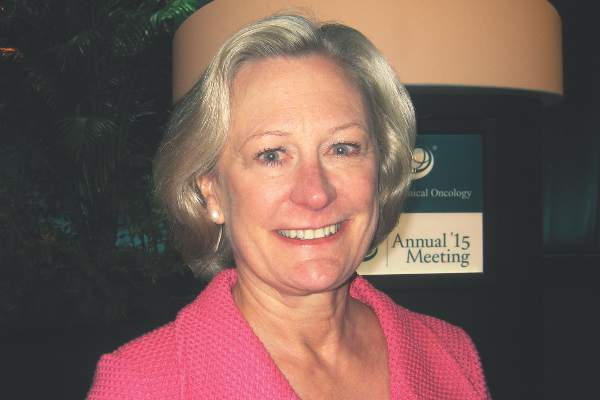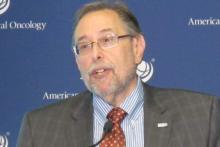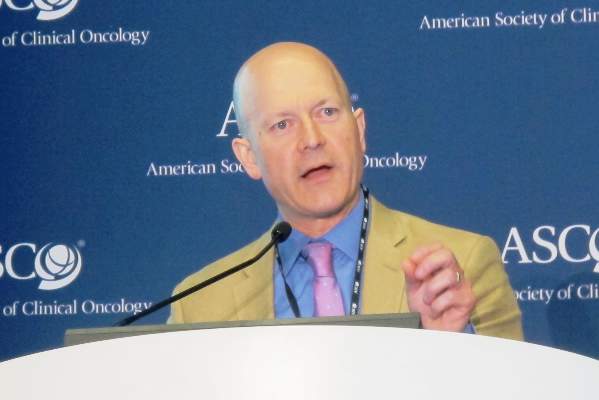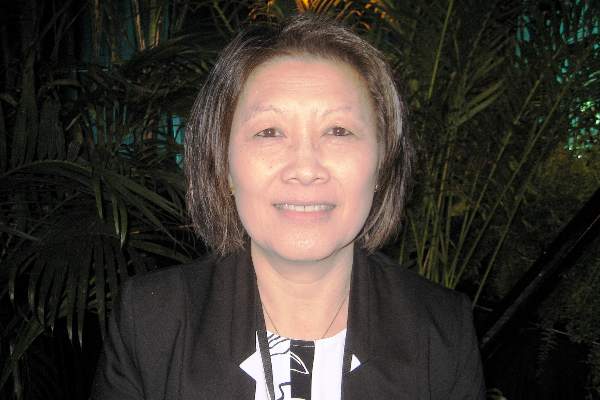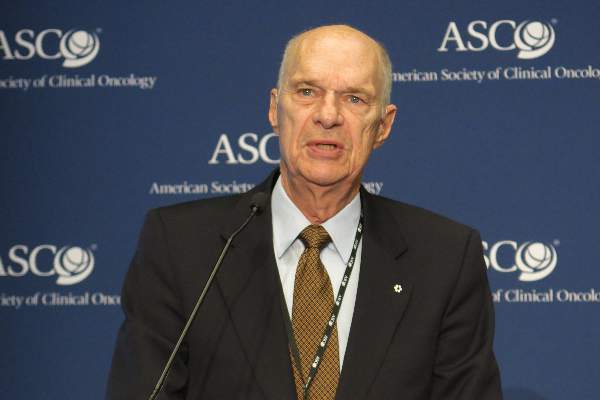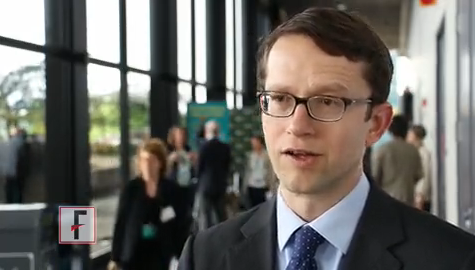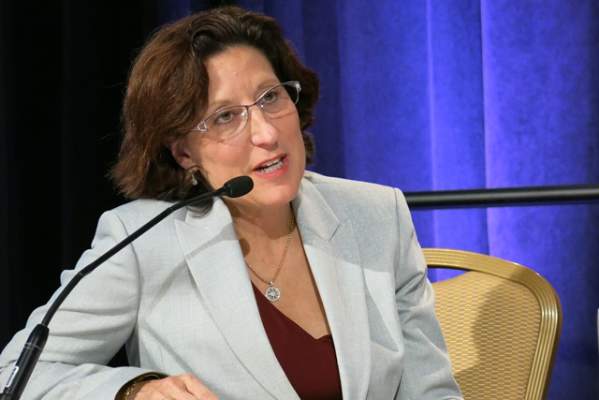User login
Three bisphosphonates found on par in early breast cancer
CHICAGO – Oral and intravenous bisphosphonates have similar efficacy and safety when used in the adjuvant breast cancer setting, but patients prefer the former, finds a phase III trial conducted by the Southwest Oncology Group (SWOG) and reported at the annual meeting of the American Society of Clinical Oncology.
Nearly 90% of the 6,097 women studied were alive and free of breast cancer at 5 years, whether they had been randomized to intravenous zoledronic acid (currently approved in the United States for treatment of multiple myeloma and cancer-related hypercalcemia) or to oral clodronate or oral ibandronate (neither of which is available in the United States). Side effect profiles differed somewhat, but three-fourths of patients indicated that they preferred oral formulations.
“SWOG S0307 shows no evidence of differences in efficacy by the type of bisphosphonate, either in an intent-to-treat analysis or based on age or tumor subtype. Overall toxicity of bisphosphonates as given in S0307 is low, and toxicity grade differed little across arms,” said Dr. Julie Gralow, director of breast medical oncology at the Seattle Cancer Care Alliance and a professor in the medical oncology division, University of Washington, both in Seattle. “Given that these oral bisphosphonates are preferred by patients and approved elsewhere, efforts to make them available in the U.S. should be considered.”
Invited discussant Dr. Robert E. Coleman of the University of Sheffield and Weston Park Hospital in England noted that the findings are consistent with a meta-analysis recently reported (San Antonio Breast Cancer Symposium 2013, abstract S4-07) and being published (Coleman R et al., Lancet 2015, in press), which shows that postmenopausal women had reductions in bone recurrences and breast cancer mortality with use of adjuvant bisphosphonates, irrespective of the agent.
“We are left now with the dilemma that the opportunity for patients to access adjuvant bisphosphonates is hampered by the lack of regulatory approval and of course the lack of interest, now that these agents have become generic, from the pharmaceutical companies” he said.
Session attendee Dr. Steven Vogl, an oncologist in the Bronx, New York, posed a question to Dr. Gralow: “Your statistics looked at two-sided tests to find the superior outcome. You found no difference. Could you tell us how it works if you are looking at this as a noninferiority test, because practically, what we’d like to do if we are going to give a bisphosphonate, we’d like to give oral clodronate. And I’d really like to know it’s not inferior to Zometa [zoledronic acid] by your study.”
“My statistician isn’t here to speak to the exact details of that analysis,” Dr. Gralow replied. “But I think it’s pretty clear with this huge study that there was absolutely no hint of a difference in absolute number between any of the arms, and no matter how we would do an analysis, I don’t think we could pull out – with exactly the same numbers of recurrences – anything that would be more statistically significant. I think that between the meta-analysis, which looks at clodronate, zoledronic acid, ibandronate across trials, and this trial, I would have complete confidence if clodronate were available in this country in using that if that were my patient’s choice. I’m left with intravenous zoledronic acid as the only one of these three drugs in S0307 available, and that is what I will offer my patients.”
Another attendee noted that whereas these data and those of the forthcoming meta-analysis suggest bisphosphonates should be used as therapy to prevent recurrence, other data also being presented at the meeting suggest adjuvant denosumab should be used to reduce fracture risk (Gnant et al., abstract 504). “This creates somewhat of a dilemma. So tomorrow morning, if I have to treat a patient with an antiresorptive agent, which should I choose?” he asked.
Dr. Gralow said that the reduction in fracture risk was comparable for the two studies. “I think [Dr. Gnant] made the statement that if you are most worried about the bone health and the bone density, then denosumab is reasonable. To date, with respect to reducing bone recurrences and death, we have the most data for the bisphosphonates,” she noted.
In the trial, Dr. Gralow and her colleagues randomized patients to 3 years of treatment with intravenous zoledronic acid, oral clodronate, or oral ibandronate. Zoledronic acid was given at 4 mg monthly for six doses, then every 3 months out to 3 years; clodronate and ibandronate were given at doses approved in other countries for the treatment of bone metastases.
The trial’s fourth preplanned interim analysis suggested that the differences in outcomes between groups would not become statistically significant, so the data safety monitoring committee recommended early reporting of the findings, according to Dr. Gralow.
At the time of analysis, the median follow-up was 5.4 years. Fifty-nine percent of the patients studied were postmenopausal at baseline.
The rate of 5-year disease-free survival, the trial’s primary endpoint, was 88% overall, with no significant difference across the three arms. Findings were the same in subgroups having different tumor types (hormone receptor positive, HER2 positive, and triple negative) and in different age groups (younger than 60 and older than 60). Five-year overall survival was 93% and likewise statistically indistinguishable across arms.
Roughly 8%-10% of patients in each arm had grade 3 or 4 toxicities. Pain was more commonly reported in the zoledronic acid and ibandronate arms, and gastrointestinal issues were more commonly reported with clodronate and ibandronate. Patients in the zoledronic acid arm had a higher rate of osteonecrosis of the jaw.
The arms were statistically indistinguishable with respect to rates of both all fractures and traumatic fractures, reported Dr. Gralow.
Overall, 76% of patients expressed a preference for oral agents at baseline as did 75% at the completion of therapy, although there was some switching between preference.
CHICAGO – Oral and intravenous bisphosphonates have similar efficacy and safety when used in the adjuvant breast cancer setting, but patients prefer the former, finds a phase III trial conducted by the Southwest Oncology Group (SWOG) and reported at the annual meeting of the American Society of Clinical Oncology.
Nearly 90% of the 6,097 women studied were alive and free of breast cancer at 5 years, whether they had been randomized to intravenous zoledronic acid (currently approved in the United States for treatment of multiple myeloma and cancer-related hypercalcemia) or to oral clodronate or oral ibandronate (neither of which is available in the United States). Side effect profiles differed somewhat, but three-fourths of patients indicated that they preferred oral formulations.
“SWOG S0307 shows no evidence of differences in efficacy by the type of bisphosphonate, either in an intent-to-treat analysis or based on age or tumor subtype. Overall toxicity of bisphosphonates as given in S0307 is low, and toxicity grade differed little across arms,” said Dr. Julie Gralow, director of breast medical oncology at the Seattle Cancer Care Alliance and a professor in the medical oncology division, University of Washington, both in Seattle. “Given that these oral bisphosphonates are preferred by patients and approved elsewhere, efforts to make them available in the U.S. should be considered.”
Invited discussant Dr. Robert E. Coleman of the University of Sheffield and Weston Park Hospital in England noted that the findings are consistent with a meta-analysis recently reported (San Antonio Breast Cancer Symposium 2013, abstract S4-07) and being published (Coleman R et al., Lancet 2015, in press), which shows that postmenopausal women had reductions in bone recurrences and breast cancer mortality with use of adjuvant bisphosphonates, irrespective of the agent.
“We are left now with the dilemma that the opportunity for patients to access adjuvant bisphosphonates is hampered by the lack of regulatory approval and of course the lack of interest, now that these agents have become generic, from the pharmaceutical companies” he said.
Session attendee Dr. Steven Vogl, an oncologist in the Bronx, New York, posed a question to Dr. Gralow: “Your statistics looked at two-sided tests to find the superior outcome. You found no difference. Could you tell us how it works if you are looking at this as a noninferiority test, because practically, what we’d like to do if we are going to give a bisphosphonate, we’d like to give oral clodronate. And I’d really like to know it’s not inferior to Zometa [zoledronic acid] by your study.”
“My statistician isn’t here to speak to the exact details of that analysis,” Dr. Gralow replied. “But I think it’s pretty clear with this huge study that there was absolutely no hint of a difference in absolute number between any of the arms, and no matter how we would do an analysis, I don’t think we could pull out – with exactly the same numbers of recurrences – anything that would be more statistically significant. I think that between the meta-analysis, which looks at clodronate, zoledronic acid, ibandronate across trials, and this trial, I would have complete confidence if clodronate were available in this country in using that if that were my patient’s choice. I’m left with intravenous zoledronic acid as the only one of these three drugs in S0307 available, and that is what I will offer my patients.”
Another attendee noted that whereas these data and those of the forthcoming meta-analysis suggest bisphosphonates should be used as therapy to prevent recurrence, other data also being presented at the meeting suggest adjuvant denosumab should be used to reduce fracture risk (Gnant et al., abstract 504). “This creates somewhat of a dilemma. So tomorrow morning, if I have to treat a patient with an antiresorptive agent, which should I choose?” he asked.
Dr. Gralow said that the reduction in fracture risk was comparable for the two studies. “I think [Dr. Gnant] made the statement that if you are most worried about the bone health and the bone density, then denosumab is reasonable. To date, with respect to reducing bone recurrences and death, we have the most data for the bisphosphonates,” she noted.
In the trial, Dr. Gralow and her colleagues randomized patients to 3 years of treatment with intravenous zoledronic acid, oral clodronate, or oral ibandronate. Zoledronic acid was given at 4 mg monthly for six doses, then every 3 months out to 3 years; clodronate and ibandronate were given at doses approved in other countries for the treatment of bone metastases.
The trial’s fourth preplanned interim analysis suggested that the differences in outcomes between groups would not become statistically significant, so the data safety monitoring committee recommended early reporting of the findings, according to Dr. Gralow.
At the time of analysis, the median follow-up was 5.4 years. Fifty-nine percent of the patients studied were postmenopausal at baseline.
The rate of 5-year disease-free survival, the trial’s primary endpoint, was 88% overall, with no significant difference across the three arms. Findings were the same in subgroups having different tumor types (hormone receptor positive, HER2 positive, and triple negative) and in different age groups (younger than 60 and older than 60). Five-year overall survival was 93% and likewise statistically indistinguishable across arms.
Roughly 8%-10% of patients in each arm had grade 3 or 4 toxicities. Pain was more commonly reported in the zoledronic acid and ibandronate arms, and gastrointestinal issues were more commonly reported with clodronate and ibandronate. Patients in the zoledronic acid arm had a higher rate of osteonecrosis of the jaw.
The arms were statistically indistinguishable with respect to rates of both all fractures and traumatic fractures, reported Dr. Gralow.
Overall, 76% of patients expressed a preference for oral agents at baseline as did 75% at the completion of therapy, although there was some switching between preference.
CHICAGO – Oral and intravenous bisphosphonates have similar efficacy and safety when used in the adjuvant breast cancer setting, but patients prefer the former, finds a phase III trial conducted by the Southwest Oncology Group (SWOG) and reported at the annual meeting of the American Society of Clinical Oncology.
Nearly 90% of the 6,097 women studied were alive and free of breast cancer at 5 years, whether they had been randomized to intravenous zoledronic acid (currently approved in the United States for treatment of multiple myeloma and cancer-related hypercalcemia) or to oral clodronate or oral ibandronate (neither of which is available in the United States). Side effect profiles differed somewhat, but three-fourths of patients indicated that they preferred oral formulations.
“SWOG S0307 shows no evidence of differences in efficacy by the type of bisphosphonate, either in an intent-to-treat analysis or based on age or tumor subtype. Overall toxicity of bisphosphonates as given in S0307 is low, and toxicity grade differed little across arms,” said Dr. Julie Gralow, director of breast medical oncology at the Seattle Cancer Care Alliance and a professor in the medical oncology division, University of Washington, both in Seattle. “Given that these oral bisphosphonates are preferred by patients and approved elsewhere, efforts to make them available in the U.S. should be considered.”
Invited discussant Dr. Robert E. Coleman of the University of Sheffield and Weston Park Hospital in England noted that the findings are consistent with a meta-analysis recently reported (San Antonio Breast Cancer Symposium 2013, abstract S4-07) and being published (Coleman R et al., Lancet 2015, in press), which shows that postmenopausal women had reductions in bone recurrences and breast cancer mortality with use of adjuvant bisphosphonates, irrespective of the agent.
“We are left now with the dilemma that the opportunity for patients to access adjuvant bisphosphonates is hampered by the lack of regulatory approval and of course the lack of interest, now that these agents have become generic, from the pharmaceutical companies” he said.
Session attendee Dr. Steven Vogl, an oncologist in the Bronx, New York, posed a question to Dr. Gralow: “Your statistics looked at two-sided tests to find the superior outcome. You found no difference. Could you tell us how it works if you are looking at this as a noninferiority test, because practically, what we’d like to do if we are going to give a bisphosphonate, we’d like to give oral clodronate. And I’d really like to know it’s not inferior to Zometa [zoledronic acid] by your study.”
“My statistician isn’t here to speak to the exact details of that analysis,” Dr. Gralow replied. “But I think it’s pretty clear with this huge study that there was absolutely no hint of a difference in absolute number between any of the arms, and no matter how we would do an analysis, I don’t think we could pull out – with exactly the same numbers of recurrences – anything that would be more statistically significant. I think that between the meta-analysis, which looks at clodronate, zoledronic acid, ibandronate across trials, and this trial, I would have complete confidence if clodronate were available in this country in using that if that were my patient’s choice. I’m left with intravenous zoledronic acid as the only one of these three drugs in S0307 available, and that is what I will offer my patients.”
Another attendee noted that whereas these data and those of the forthcoming meta-analysis suggest bisphosphonates should be used as therapy to prevent recurrence, other data also being presented at the meeting suggest adjuvant denosumab should be used to reduce fracture risk (Gnant et al., abstract 504). “This creates somewhat of a dilemma. So tomorrow morning, if I have to treat a patient with an antiresorptive agent, which should I choose?” he asked.
Dr. Gralow said that the reduction in fracture risk was comparable for the two studies. “I think [Dr. Gnant] made the statement that if you are most worried about the bone health and the bone density, then denosumab is reasonable. To date, with respect to reducing bone recurrences and death, we have the most data for the bisphosphonates,” she noted.
In the trial, Dr. Gralow and her colleagues randomized patients to 3 years of treatment with intravenous zoledronic acid, oral clodronate, or oral ibandronate. Zoledronic acid was given at 4 mg monthly for six doses, then every 3 months out to 3 years; clodronate and ibandronate were given at doses approved in other countries for the treatment of bone metastases.
The trial’s fourth preplanned interim analysis suggested that the differences in outcomes between groups would not become statistically significant, so the data safety monitoring committee recommended early reporting of the findings, according to Dr. Gralow.
At the time of analysis, the median follow-up was 5.4 years. Fifty-nine percent of the patients studied were postmenopausal at baseline.
The rate of 5-year disease-free survival, the trial’s primary endpoint, was 88% overall, with no significant difference across the three arms. Findings were the same in subgroups having different tumor types (hormone receptor positive, HER2 positive, and triple negative) and in different age groups (younger than 60 and older than 60). Five-year overall survival was 93% and likewise statistically indistinguishable across arms.
Roughly 8%-10% of patients in each arm had grade 3 or 4 toxicities. Pain was more commonly reported in the zoledronic acid and ibandronate arms, and gastrointestinal issues were more commonly reported with clodronate and ibandronate. Patients in the zoledronic acid arm had a higher rate of osteonecrosis of the jaw.
The arms were statistically indistinguishable with respect to rates of both all fractures and traumatic fractures, reported Dr. Gralow.
Overall, 76% of patients expressed a preference for oral agents at baseline as did 75% at the completion of therapy, although there was some switching between preference.
AT THE 2015 ASCO ANNUAL MEETING
Key clinical point: Adjuvant zoledronic acid, clodronate, and ibandronate yield similar disease-free survival in early breast cancer.
Major finding: Five-year disease-free survival was 88% with no significant difference across the three bisphosphonates.
Data source: A randomized phase III trial among 6,097 women receiving adjuvant systemic therapy for stage I-III breast cancer.
Disclosures: Dr. Gralow disclosed that she has a consulting or advisory role with Genentech and Novartis, and her institution receives research funding from Amgen, Novartis, and Roche/Genentech.
ASCO: Precision medicine initiatives take wing
CHICAGO – It’s getting very personal in oncology, and that’s a very good thing.
At the annual meeting of the American Society of Clinical Oncology, major cancer organizations announced new precision medicine initiatives that will attempt to match patients who have advanced cancers with the best available therapies based not on the location or histologic subtypes of their tumors, but on specific molecular abnormalities.
The National Cancer Institute’s Molecular Analysis for Therapy Choice (NCI-MATCH) trial will begin enrolling patients in July 2015. The study’s objective is “to understand the relative efficacy of the same therapy applied to oncogene-defined subsets across the entire cancer population as defined by site of origin or tumor histology,” said co–principal investigator Dr. Keith T. Flaherty of Harvard Medical School, Boston.
“This is the beginning, not the end, in terms of how we think about applying these therapies,” he said at a briefing that was held to announce the start of trial enrollment and a second initiative – the Targeted Agent and Profiling Utilization Registry (TAPUR) Study – by ASCO in cooperation with major pharmaceutical companies.
NCI-MATCH
NCI-MATCH is a phase II trial that will be operated through the National Clinical Trials Network. Oncologists at participating centers throughout the United States can enroll patients aged 18 years and older who have solid tumors or lymphomas that have relapsed or are refractory to conventional therapy, or who have a type of cancer for which no effective, consensus-based therapy is available.
Investigators plan to screen 3,000 patients initially, with the goal of enrolling 1,000 patients distributed among several substudies that will be evaluating specific drugs against specific molecular targets.
Patients will undergo biopsy at study entry, and their tumors will be subjected to genomic analysis to detect specific, targetable molecular abnormalities.
If a patient has a specific abnormality that is being explored in a current substudy, that patient will be further evaluated to determine whether he or she meets the eligibility criteria for that trial arm. Once enrolled, patients can remain on therapy until disease progression. The therapies will include both currently marketed agents and investigational therapies contributed by drug companies. Most of the trial arms will explore monotherapy with a targeted agent, but a few may investigate combinations which have accumulated enough safety and efficacy data to suggest that they might work against a specific molecular target.
The primary endpoint will be overall response rate, with a secondary endpoint of 6-month progression-free survival (PFS).
“This holds promise to bring faster cures to millions of Americans who so desperately need them,” ASCO past president Dr. Clifford A. Hudis said at the briefing.
TAPUR Trial
In cooperation with major pharmaceutical manufacturers (currently five, with more expected to sign on), ASCO has initiated a study designed to help answer the question, “I’ve got the tumor genome – now what do I do with it?”
The goal of the TAPUR trial, says ASCO Chief Medical Officer Dr. Richard Schilsky, is “to learn from the real world practice of prescribing targeted therapies to patients with advanced cancer whose tumor harbors a genomic variant known to be a drug target.”
The primary objectives are to describe the antitumor activity and toxicity profiles of targeted therapies, and to help patients get access to Food and Drug Administration–approved agents from which they may be able to benefit.
The trial will enroll patients with advanced solid tumors, B-cell non-Hodgkin’s lymphomas, and multiple myelomas for which there are no standard therapies. The patients must have adequate organ function and good performance status (0-2).
Patients will be matched by their personal physicians to specific therapies, if such a match exists; otherwise, they will be treated at the physician’s discretion.
The primary endpoint of the study will be overall response rates by Response Evaluation Criteria in Solid Tumors (RECIST). Secondary endpoints will be PFS, OS, time on treatment, grade 3 or greater adverse events, and serious adverse event. The investigators plan to begin patient enrollment in the fourth quarter of 2015.
Current industry partners include AstraZeneca, Bristol Myers Squibb, Eli Lilly, Genentech, and Pfizer.
The NCI-MATCH study is funded by the National Institutes of Health. Dr. Flaherty has received NIH research grants. Dr. Hudis disclosed ties to AstraZeneca, Sanofi-Aventis, Amgen, Bristol-Myers Squibb, Genentech, Eli Lilly, Novartis, Ortho Biotech, Pfizer, and Roche. Dr. Schilsky disclosed no relevant conflicts of interest.
CHICAGO – It’s getting very personal in oncology, and that’s a very good thing.
At the annual meeting of the American Society of Clinical Oncology, major cancer organizations announced new precision medicine initiatives that will attempt to match patients who have advanced cancers with the best available therapies based not on the location or histologic subtypes of their tumors, but on specific molecular abnormalities.
The National Cancer Institute’s Molecular Analysis for Therapy Choice (NCI-MATCH) trial will begin enrolling patients in July 2015. The study’s objective is “to understand the relative efficacy of the same therapy applied to oncogene-defined subsets across the entire cancer population as defined by site of origin or tumor histology,” said co–principal investigator Dr. Keith T. Flaherty of Harvard Medical School, Boston.
“This is the beginning, not the end, in terms of how we think about applying these therapies,” he said at a briefing that was held to announce the start of trial enrollment and a second initiative – the Targeted Agent and Profiling Utilization Registry (TAPUR) Study – by ASCO in cooperation with major pharmaceutical companies.
NCI-MATCH
NCI-MATCH is a phase II trial that will be operated through the National Clinical Trials Network. Oncologists at participating centers throughout the United States can enroll patients aged 18 years and older who have solid tumors or lymphomas that have relapsed or are refractory to conventional therapy, or who have a type of cancer for which no effective, consensus-based therapy is available.
Investigators plan to screen 3,000 patients initially, with the goal of enrolling 1,000 patients distributed among several substudies that will be evaluating specific drugs against specific molecular targets.
Patients will undergo biopsy at study entry, and their tumors will be subjected to genomic analysis to detect specific, targetable molecular abnormalities.
If a patient has a specific abnormality that is being explored in a current substudy, that patient will be further evaluated to determine whether he or she meets the eligibility criteria for that trial arm. Once enrolled, patients can remain on therapy until disease progression. The therapies will include both currently marketed agents and investigational therapies contributed by drug companies. Most of the trial arms will explore monotherapy with a targeted agent, but a few may investigate combinations which have accumulated enough safety and efficacy data to suggest that they might work against a specific molecular target.
The primary endpoint will be overall response rate, with a secondary endpoint of 6-month progression-free survival (PFS).
“This holds promise to bring faster cures to millions of Americans who so desperately need them,” ASCO past president Dr. Clifford A. Hudis said at the briefing.
TAPUR Trial
In cooperation with major pharmaceutical manufacturers (currently five, with more expected to sign on), ASCO has initiated a study designed to help answer the question, “I’ve got the tumor genome – now what do I do with it?”
The goal of the TAPUR trial, says ASCO Chief Medical Officer Dr. Richard Schilsky, is “to learn from the real world practice of prescribing targeted therapies to patients with advanced cancer whose tumor harbors a genomic variant known to be a drug target.”
The primary objectives are to describe the antitumor activity and toxicity profiles of targeted therapies, and to help patients get access to Food and Drug Administration–approved agents from which they may be able to benefit.
The trial will enroll patients with advanced solid tumors, B-cell non-Hodgkin’s lymphomas, and multiple myelomas for which there are no standard therapies. The patients must have adequate organ function and good performance status (0-2).
Patients will be matched by their personal physicians to specific therapies, if such a match exists; otherwise, they will be treated at the physician’s discretion.
The primary endpoint of the study will be overall response rates by Response Evaluation Criteria in Solid Tumors (RECIST). Secondary endpoints will be PFS, OS, time on treatment, grade 3 or greater adverse events, and serious adverse event. The investigators plan to begin patient enrollment in the fourth quarter of 2015.
Current industry partners include AstraZeneca, Bristol Myers Squibb, Eli Lilly, Genentech, and Pfizer.
The NCI-MATCH study is funded by the National Institutes of Health. Dr. Flaherty has received NIH research grants. Dr. Hudis disclosed ties to AstraZeneca, Sanofi-Aventis, Amgen, Bristol-Myers Squibb, Genentech, Eli Lilly, Novartis, Ortho Biotech, Pfizer, and Roche. Dr. Schilsky disclosed no relevant conflicts of interest.
CHICAGO – It’s getting very personal in oncology, and that’s a very good thing.
At the annual meeting of the American Society of Clinical Oncology, major cancer organizations announced new precision medicine initiatives that will attempt to match patients who have advanced cancers with the best available therapies based not on the location or histologic subtypes of their tumors, but on specific molecular abnormalities.
The National Cancer Institute’s Molecular Analysis for Therapy Choice (NCI-MATCH) trial will begin enrolling patients in July 2015. The study’s objective is “to understand the relative efficacy of the same therapy applied to oncogene-defined subsets across the entire cancer population as defined by site of origin or tumor histology,” said co–principal investigator Dr. Keith T. Flaherty of Harvard Medical School, Boston.
“This is the beginning, not the end, in terms of how we think about applying these therapies,” he said at a briefing that was held to announce the start of trial enrollment and a second initiative – the Targeted Agent and Profiling Utilization Registry (TAPUR) Study – by ASCO in cooperation with major pharmaceutical companies.
NCI-MATCH
NCI-MATCH is a phase II trial that will be operated through the National Clinical Trials Network. Oncologists at participating centers throughout the United States can enroll patients aged 18 years and older who have solid tumors or lymphomas that have relapsed or are refractory to conventional therapy, or who have a type of cancer for which no effective, consensus-based therapy is available.
Investigators plan to screen 3,000 patients initially, with the goal of enrolling 1,000 patients distributed among several substudies that will be evaluating specific drugs against specific molecular targets.
Patients will undergo biopsy at study entry, and their tumors will be subjected to genomic analysis to detect specific, targetable molecular abnormalities.
If a patient has a specific abnormality that is being explored in a current substudy, that patient will be further evaluated to determine whether he or she meets the eligibility criteria for that trial arm. Once enrolled, patients can remain on therapy until disease progression. The therapies will include both currently marketed agents and investigational therapies contributed by drug companies. Most of the trial arms will explore monotherapy with a targeted agent, but a few may investigate combinations which have accumulated enough safety and efficacy data to suggest that they might work against a specific molecular target.
The primary endpoint will be overall response rate, with a secondary endpoint of 6-month progression-free survival (PFS).
“This holds promise to bring faster cures to millions of Americans who so desperately need them,” ASCO past president Dr. Clifford A. Hudis said at the briefing.
TAPUR Trial
In cooperation with major pharmaceutical manufacturers (currently five, with more expected to sign on), ASCO has initiated a study designed to help answer the question, “I’ve got the tumor genome – now what do I do with it?”
The goal of the TAPUR trial, says ASCO Chief Medical Officer Dr. Richard Schilsky, is “to learn from the real world practice of prescribing targeted therapies to patients with advanced cancer whose tumor harbors a genomic variant known to be a drug target.”
The primary objectives are to describe the antitumor activity and toxicity profiles of targeted therapies, and to help patients get access to Food and Drug Administration–approved agents from which they may be able to benefit.
The trial will enroll patients with advanced solid tumors, B-cell non-Hodgkin’s lymphomas, and multiple myelomas for which there are no standard therapies. The patients must have adequate organ function and good performance status (0-2).
Patients will be matched by their personal physicians to specific therapies, if such a match exists; otherwise, they will be treated at the physician’s discretion.
The primary endpoint of the study will be overall response rates by Response Evaluation Criteria in Solid Tumors (RECIST). Secondary endpoints will be PFS, OS, time on treatment, grade 3 or greater adverse events, and serious adverse event. The investigators plan to begin patient enrollment in the fourth quarter of 2015.
Current industry partners include AstraZeneca, Bristol Myers Squibb, Eli Lilly, Genentech, and Pfizer.
The NCI-MATCH study is funded by the National Institutes of Health. Dr. Flaherty has received NIH research grants. Dr. Hudis disclosed ties to AstraZeneca, Sanofi-Aventis, Amgen, Bristol-Myers Squibb, Genentech, Eli Lilly, Novartis, Ortho Biotech, Pfizer, and Roche. Dr. Schilsky disclosed no relevant conflicts of interest.
AT THE 2015 ASCO ANNUAL MEETING
ASCO: Adjuvant neratinib has payoff in HER2-positive breast cancer
CHICAGO – Extending adjuvant targeted therapy for HER2-positive early breast cancer by a year with neratinib further protects against recurrence, suggest primary results of the phase III randomized ExteNET trial (Study Evaluating the Effects of Neratinib After Adjuvant Trastuzumab in Women With Early-Stage Breast Cancer).
At 2 years of follow-up, women assigned to receive neratinib, an investigational pan-HER tyrosine kinase inhibitor, had a one-third reduction in the risk of invasive breast cancer or death relative to counterparts assigned to receive placebo, with an absolute difference between groups of 2.3%, investigators reported at the annual meeting of the American Society of Clinical Oncology. Benefit was even greater among the subset whose tumor had hormone receptors.
“The ExteNET study, utilizing 12 months of neratinib therapy, is the first study … to demonstrate a significant improvement in invasive disease–free survival at 2 years. The underlying [molecular] cross-talk mechanism, which may explain the observed greater benefit in the hormone receptor–positive cohort, clearly requires further evaluation in other studies,” said Dr. Arlene Chan, a medical oncologist at the Breast Cancer Research Centre of Western Australia and Mount Medical Centre, both in Perth.
Grade 3 or 4 diarrhea was problematic, however, occurring in 40% of the neratinib group and often leading to dose reductions and discontinuations. “Studies have shown that the incidence of diarrhea can be attenuated with the use of an intensive loperamide prophylaxis regimen, and we believe that by adopting this approach, it will make this treatment far more tolerable for all our patients,” she noted.
Invited discussant Dr. Shanu Modi of Memorial Sloan Kettering Cancer Center, New York, noted that there are factors weighing both for and against making extended therapy with neratinib a new standard of care.
“On the one hand, the absolute disease-free survival gain is real, and if you recall, these results are similar to what we saw with the 2-year data for the original adjuvant trastuzumab studies,” she elaborated. “But on the other hand, we don’t have overall survival data, and that is something we did have with the trastuzumab trials. Additionally, from a practical perspective, to which population do we apply these results? In the U.S., pertuzumab is an option for our high-risk HER2-positive patients, so would the benefit seen with neratinib persist in these pertuzumab-pretreated patients? For our lower-risk patients, stage 1 patients, for whom we have very effective taxane-based therapies, how do we justify the risks of treatment for the potential small benefits expected in this group that already does very well?”
“We await the longer follow-up and FDA deliberations to determine how and whether to offer neratinib as extended therapy to our early-stage patients,” Dr. Modi concluded. “How will these ExteNET data apply to patients who have received pertuzumab? This is an area where further clinical research could guide us forward.”
Session attendee Richard Gelber, Ph.D., of the Dana-Farber Cancer Institute, Boston, agreed with Dr. Chan that the trial’s short follow-up is a limitation. “I would hypothesize that it’s actually a fatal limitation for the results we saw today. I would consider the results nonactionable. In fact, the early results of ALTTO done at about that time showed an even larger advantage than we saw here today,” he said, referring to an adjuvant trial of lapatinib that was ultimately negative. “Similar pathway, and I would propose that the longer-term follow-up would likely prove a negative result.”
Dr. Chan replied: “I think that in terms of the absolute benefit derived from our study, we need to take it in the context that this is added upon a treatment intervention with trastuzumab, which has already provided an enormous benefit for our patients,” so it may be unreasonable to expect another large gain; furthermore, the MA.17 trial, which investigated extended adjuvant hormonal therapy, had an even smaller benefit at the 2-year mark, but eventually concluded in favor of the therapy. She added that the ExteNET trial will continue to follow patients out to 5 years.
Dr. Steven Vogl, an oncologist in the Bronx, New York, didn’t mince words about the observed toxicity, saying, “This neratinib sounds like a terrible drug. How many people were still taking it after 6 months and how many actually finished a year of the stuff?”
The relative dose intensity was 81% in the neratinib arm, compared with 98% in the placebo arm, according to Dr. Chan. Only 61% of patients in the former were able to complete the full year of planned treatment.
“Seeing an impressive response with that degree of noncompliance suggests that maybe you don’t need as much drug as you gave,” Dr. Vogl proposed.
ExteNET, sponsored by Puma Biotechnology, enrolled 2,840 women who had completed adjuvant chemotherapy and trastuzumab (Herceptin) for early breast cancer that was HER2 positive by local assessment. The women were randomized evenly to neratinib – an oral irreversible inhibitor of HER 1, 2, and 4 shown to be active in trastuzumab-pretreated patients – or placebo.
The study had a complex evolution, with several major amendments of the protocol due to new results from other trials and changes in sponsorship, Dr. Chan noted. Initially, women were required to have stage 1 to 3c disease with receipt of the last trastuzumab dose no more than 2 years earlier; later, that was modified to stage 2 to 3 disease and receipt of the last trastuzumab dose no more than 1 year earlier. Also, the duration of follow-up was temporarily shortened from 5 years to 2 years.
In intention-to-treat analyses, the 2-year rate of invasive disease–free survival was 93.9% with neratinib and 91.6% with placebo (hazard ratio, 0.67; P = .009), reported Dr. Chan, who disclosed that she has a consulting or advisory role with Pfizer, and that she is on the speakers’ bureau and is provided with travel, accommodation, and expenses by Pierre Fabre.
In some noteworthy subgroup findings, benefit was even greater among women with hormone receptor–positive disease (hazard ratio, 0.51; P = .001) or centrally confirmed HER2-positive disease (hazard ratio, 0.51; P = .002).
The neratinib group also had a significantly better rate of survival with freedom from invasive and in situ disease combined (93.9% vs. 91.0%; hazard ratio, 0.63; P = .002).
In terms of adverse events of special interest, neratinib was associated with a sharply higher rate of grade 3 or 4 diarrhea when compared to placebo (40% vs. 2%), as expected from its mechanism of action, Dr. Chan said. But rates of cardiac toxicity and interstitial lung disease did not differ between groups.
CHICAGO – Extending adjuvant targeted therapy for HER2-positive early breast cancer by a year with neratinib further protects against recurrence, suggest primary results of the phase III randomized ExteNET trial (Study Evaluating the Effects of Neratinib After Adjuvant Trastuzumab in Women With Early-Stage Breast Cancer).
At 2 years of follow-up, women assigned to receive neratinib, an investigational pan-HER tyrosine kinase inhibitor, had a one-third reduction in the risk of invasive breast cancer or death relative to counterparts assigned to receive placebo, with an absolute difference between groups of 2.3%, investigators reported at the annual meeting of the American Society of Clinical Oncology. Benefit was even greater among the subset whose tumor had hormone receptors.
“The ExteNET study, utilizing 12 months of neratinib therapy, is the first study … to demonstrate a significant improvement in invasive disease–free survival at 2 years. The underlying [molecular] cross-talk mechanism, which may explain the observed greater benefit in the hormone receptor–positive cohort, clearly requires further evaluation in other studies,” said Dr. Arlene Chan, a medical oncologist at the Breast Cancer Research Centre of Western Australia and Mount Medical Centre, both in Perth.
Grade 3 or 4 diarrhea was problematic, however, occurring in 40% of the neratinib group and often leading to dose reductions and discontinuations. “Studies have shown that the incidence of diarrhea can be attenuated with the use of an intensive loperamide prophylaxis regimen, and we believe that by adopting this approach, it will make this treatment far more tolerable for all our patients,” she noted.
Invited discussant Dr. Shanu Modi of Memorial Sloan Kettering Cancer Center, New York, noted that there are factors weighing both for and against making extended therapy with neratinib a new standard of care.
“On the one hand, the absolute disease-free survival gain is real, and if you recall, these results are similar to what we saw with the 2-year data for the original adjuvant trastuzumab studies,” she elaborated. “But on the other hand, we don’t have overall survival data, and that is something we did have with the trastuzumab trials. Additionally, from a practical perspective, to which population do we apply these results? In the U.S., pertuzumab is an option for our high-risk HER2-positive patients, so would the benefit seen with neratinib persist in these pertuzumab-pretreated patients? For our lower-risk patients, stage 1 patients, for whom we have very effective taxane-based therapies, how do we justify the risks of treatment for the potential small benefits expected in this group that already does very well?”
“We await the longer follow-up and FDA deliberations to determine how and whether to offer neratinib as extended therapy to our early-stage patients,” Dr. Modi concluded. “How will these ExteNET data apply to patients who have received pertuzumab? This is an area where further clinical research could guide us forward.”
Session attendee Richard Gelber, Ph.D., of the Dana-Farber Cancer Institute, Boston, agreed with Dr. Chan that the trial’s short follow-up is a limitation. “I would hypothesize that it’s actually a fatal limitation for the results we saw today. I would consider the results nonactionable. In fact, the early results of ALTTO done at about that time showed an even larger advantage than we saw here today,” he said, referring to an adjuvant trial of lapatinib that was ultimately negative. “Similar pathway, and I would propose that the longer-term follow-up would likely prove a negative result.”
Dr. Chan replied: “I think that in terms of the absolute benefit derived from our study, we need to take it in the context that this is added upon a treatment intervention with trastuzumab, which has already provided an enormous benefit for our patients,” so it may be unreasonable to expect another large gain; furthermore, the MA.17 trial, which investigated extended adjuvant hormonal therapy, had an even smaller benefit at the 2-year mark, but eventually concluded in favor of the therapy. She added that the ExteNET trial will continue to follow patients out to 5 years.
Dr. Steven Vogl, an oncologist in the Bronx, New York, didn’t mince words about the observed toxicity, saying, “This neratinib sounds like a terrible drug. How many people were still taking it after 6 months and how many actually finished a year of the stuff?”
The relative dose intensity was 81% in the neratinib arm, compared with 98% in the placebo arm, according to Dr. Chan. Only 61% of patients in the former were able to complete the full year of planned treatment.
“Seeing an impressive response with that degree of noncompliance suggests that maybe you don’t need as much drug as you gave,” Dr. Vogl proposed.
ExteNET, sponsored by Puma Biotechnology, enrolled 2,840 women who had completed adjuvant chemotherapy and trastuzumab (Herceptin) for early breast cancer that was HER2 positive by local assessment. The women were randomized evenly to neratinib – an oral irreversible inhibitor of HER 1, 2, and 4 shown to be active in trastuzumab-pretreated patients – or placebo.
The study had a complex evolution, with several major amendments of the protocol due to new results from other trials and changes in sponsorship, Dr. Chan noted. Initially, women were required to have stage 1 to 3c disease with receipt of the last trastuzumab dose no more than 2 years earlier; later, that was modified to stage 2 to 3 disease and receipt of the last trastuzumab dose no more than 1 year earlier. Also, the duration of follow-up was temporarily shortened from 5 years to 2 years.
In intention-to-treat analyses, the 2-year rate of invasive disease–free survival was 93.9% with neratinib and 91.6% with placebo (hazard ratio, 0.67; P = .009), reported Dr. Chan, who disclosed that she has a consulting or advisory role with Pfizer, and that she is on the speakers’ bureau and is provided with travel, accommodation, and expenses by Pierre Fabre.
In some noteworthy subgroup findings, benefit was even greater among women with hormone receptor–positive disease (hazard ratio, 0.51; P = .001) or centrally confirmed HER2-positive disease (hazard ratio, 0.51; P = .002).
The neratinib group also had a significantly better rate of survival with freedom from invasive and in situ disease combined (93.9% vs. 91.0%; hazard ratio, 0.63; P = .002).
In terms of adverse events of special interest, neratinib was associated with a sharply higher rate of grade 3 or 4 diarrhea when compared to placebo (40% vs. 2%), as expected from its mechanism of action, Dr. Chan said. But rates of cardiac toxicity and interstitial lung disease did not differ between groups.
CHICAGO – Extending adjuvant targeted therapy for HER2-positive early breast cancer by a year with neratinib further protects against recurrence, suggest primary results of the phase III randomized ExteNET trial (Study Evaluating the Effects of Neratinib After Adjuvant Trastuzumab in Women With Early-Stage Breast Cancer).
At 2 years of follow-up, women assigned to receive neratinib, an investigational pan-HER tyrosine kinase inhibitor, had a one-third reduction in the risk of invasive breast cancer or death relative to counterparts assigned to receive placebo, with an absolute difference between groups of 2.3%, investigators reported at the annual meeting of the American Society of Clinical Oncology. Benefit was even greater among the subset whose tumor had hormone receptors.
“The ExteNET study, utilizing 12 months of neratinib therapy, is the first study … to demonstrate a significant improvement in invasive disease–free survival at 2 years. The underlying [molecular] cross-talk mechanism, which may explain the observed greater benefit in the hormone receptor–positive cohort, clearly requires further evaluation in other studies,” said Dr. Arlene Chan, a medical oncologist at the Breast Cancer Research Centre of Western Australia and Mount Medical Centre, both in Perth.
Grade 3 or 4 diarrhea was problematic, however, occurring in 40% of the neratinib group and often leading to dose reductions and discontinuations. “Studies have shown that the incidence of diarrhea can be attenuated with the use of an intensive loperamide prophylaxis regimen, and we believe that by adopting this approach, it will make this treatment far more tolerable for all our patients,” she noted.
Invited discussant Dr. Shanu Modi of Memorial Sloan Kettering Cancer Center, New York, noted that there are factors weighing both for and against making extended therapy with neratinib a new standard of care.
“On the one hand, the absolute disease-free survival gain is real, and if you recall, these results are similar to what we saw with the 2-year data for the original adjuvant trastuzumab studies,” she elaborated. “But on the other hand, we don’t have overall survival data, and that is something we did have with the trastuzumab trials. Additionally, from a practical perspective, to which population do we apply these results? In the U.S., pertuzumab is an option for our high-risk HER2-positive patients, so would the benefit seen with neratinib persist in these pertuzumab-pretreated patients? For our lower-risk patients, stage 1 patients, for whom we have very effective taxane-based therapies, how do we justify the risks of treatment for the potential small benefits expected in this group that already does very well?”
“We await the longer follow-up and FDA deliberations to determine how and whether to offer neratinib as extended therapy to our early-stage patients,” Dr. Modi concluded. “How will these ExteNET data apply to patients who have received pertuzumab? This is an area where further clinical research could guide us forward.”
Session attendee Richard Gelber, Ph.D., of the Dana-Farber Cancer Institute, Boston, agreed with Dr. Chan that the trial’s short follow-up is a limitation. “I would hypothesize that it’s actually a fatal limitation for the results we saw today. I would consider the results nonactionable. In fact, the early results of ALTTO done at about that time showed an even larger advantage than we saw here today,” he said, referring to an adjuvant trial of lapatinib that was ultimately negative. “Similar pathway, and I would propose that the longer-term follow-up would likely prove a negative result.”
Dr. Chan replied: “I think that in terms of the absolute benefit derived from our study, we need to take it in the context that this is added upon a treatment intervention with trastuzumab, which has already provided an enormous benefit for our patients,” so it may be unreasonable to expect another large gain; furthermore, the MA.17 trial, which investigated extended adjuvant hormonal therapy, had an even smaller benefit at the 2-year mark, but eventually concluded in favor of the therapy. She added that the ExteNET trial will continue to follow patients out to 5 years.
Dr. Steven Vogl, an oncologist in the Bronx, New York, didn’t mince words about the observed toxicity, saying, “This neratinib sounds like a terrible drug. How many people were still taking it after 6 months and how many actually finished a year of the stuff?”
The relative dose intensity was 81% in the neratinib arm, compared with 98% in the placebo arm, according to Dr. Chan. Only 61% of patients in the former were able to complete the full year of planned treatment.
“Seeing an impressive response with that degree of noncompliance suggests that maybe you don’t need as much drug as you gave,” Dr. Vogl proposed.
ExteNET, sponsored by Puma Biotechnology, enrolled 2,840 women who had completed adjuvant chemotherapy and trastuzumab (Herceptin) for early breast cancer that was HER2 positive by local assessment. The women were randomized evenly to neratinib – an oral irreversible inhibitor of HER 1, 2, and 4 shown to be active in trastuzumab-pretreated patients – or placebo.
The study had a complex evolution, with several major amendments of the protocol due to new results from other trials and changes in sponsorship, Dr. Chan noted. Initially, women were required to have stage 1 to 3c disease with receipt of the last trastuzumab dose no more than 2 years earlier; later, that was modified to stage 2 to 3 disease and receipt of the last trastuzumab dose no more than 1 year earlier. Also, the duration of follow-up was temporarily shortened from 5 years to 2 years.
In intention-to-treat analyses, the 2-year rate of invasive disease–free survival was 93.9% with neratinib and 91.6% with placebo (hazard ratio, 0.67; P = .009), reported Dr. Chan, who disclosed that she has a consulting or advisory role with Pfizer, and that she is on the speakers’ bureau and is provided with travel, accommodation, and expenses by Pierre Fabre.
In some noteworthy subgroup findings, benefit was even greater among women with hormone receptor–positive disease (hazard ratio, 0.51; P = .001) or centrally confirmed HER2-positive disease (hazard ratio, 0.51; P = .002).
The neratinib group also had a significantly better rate of survival with freedom from invasive and in situ disease combined (93.9% vs. 91.0%; hazard ratio, 0.63; P = .002).
In terms of adverse events of special interest, neratinib was associated with a sharply higher rate of grade 3 or 4 diarrhea when compared to placebo (40% vs. 2%), as expected from its mechanism of action, Dr. Chan said. But rates of cardiac toxicity and interstitial lung disease did not differ between groups.
AT ASCO 2015
Key clinical point: Neratinib reduces the risk of recurrence of invasive disease in women with early HER2-positive breast cancer.
Major finding: The 2-year risk of invasive disease or death was 33% lower in the neratinib group versus the placebo group.
Data source: A phase III randomized trial among 2,840 women who had completed standard adjuvant therapy for HER2-positive early breast cancer.
Disclosures: Dr. Chan disclosed that she has a consulting or advisory role with Pfizer, and that she is on the speakers’ bureau and is provided with travel, accommodation, and expenses from Pierre Fabre. The trial is sponsored by Puma Biotechnology Inc.
Anastrozole provides alternative option for DCIS
CHICAGO – The aromatase inhibitor anastrozole reduces the risk of disease recurrence better than tamoxifen for postmenopausal ductal carcinoma in situ (DCIS), particularly in younger women, preliminary results of a phase III study show.
At 10 years, 93.5% of women treated with anastrozole (Arimidex) were breast cancer free, compared with 89.2% of women treated with tamoxifen (Nolvadex) (hazard ratio, 0.73; P value = .03).
This benefit was driven by a significant effect for anastrozole in younger women aged less than 60 years (HR, 0.52; P = .003), but not in those aged 60 years and older (HR, 0.95; P = 0.77). The interaction between treatment and age was statistically significant (P = .04), Dr. Richard Margolese reported in a late-breaking abstract at the annual meeting of the American Society of Clinical Oncology.
“We now have another option for adjuvant therapy with DCIS. Women can take tamoxifen or anastrozole and, if they’re in the right group, it might be preferable to take anastrozole,” Dr. Margolese, professor of surgical oncology at Jewish General Hospital, McGill University, Montreal, said.
Aromatase inhibitors have been shown in invasive cancer to be superior to tamoxifen with regard to improved disease-free survival (DFS) and reduced contralateral breast cancer.
To determine whether they could offer better suppression with fewer side effects in DCIS, investigators for the NRG Oncology/NSABP B-35 study randomly assigned 3,104 postmenopausal women with DCIS treated by lumpectomy to tamoxifen 20 mg/day or anastrozole 1 mg/day, each for 5 years plus breast radiation. Patients could have estrogen receptor– or progesterone receptor–positive disease. Most were white (87.4%), and 53% were at least 60 years old. Median follow-up was 9 years.
At 10 years, DFS rates were similar between the anastrozole and tamoxifen groups (82.7% vs. 77.9%; P = .21).
When broken down by age, however, once again the benefit with anastrozole was significant in younger women (HR, 0.69, P = .02), but not in older women (HR, 1.03; P = .79), Dr. Margolese said.
Overall survival rates at 10 years were similar at 92.1% in the tamoxifen group and 92.5% in the anastrozole group (P =.48).
The number of uterine cancers, one of the more worrisome side effects of tamoxifen, was reduced from 17 with tamoxifen to 8 with anastrozole, but the confidence intervals were too wide to be meaningful (relative risk, 0.47; 95% CI, 0.18-1.15), he said.
As expected, osteoporotic fractures were higher with anastrozole at 69 vs. 50 with tamoxifen, but the difference also was not significant (RR, 1.38; 95% CI, 0.95-2.03).
With respect to thromboembolic events, grade 2 deep vein thrombosis was reported in 4 patients treated with tamoxifen and 1 treated with anastrozole. In the tamoxifen group, 20 patients had grade 3 pulmonary embolism, and 17 had grade 4 life-threatening PE, compared with 8 and 3 patients, respectively, in the anastrozole group. There was one thromboembolic death, with anastrozole, Dr. Margolese said.
Grade 0-1 hot flashes were more common with anastrozole than tamoxifen (965 events vs. 881 events), while the reverse was true for grade 2 hot flashes (570 events vs. 654 events). No grade 3 or 4 events occurred.
Joint and muscle pains are widely known to be a problem peculiar to aromatase inhibitors, but a self-report system showed roughly equal rates of these events in the two groups, Dr. Margolese said. Most tamoxifen and anastrozole patients reported low-grade 0-1 arthralgia events (1,177 vs. 1,031), with fewer grade 2 (302 vs. 427) or grade 3 (55 vs. 77) events, and only 1 grade 4 event with tamoxifen. Myalgia followed a similar pattern: grade 0-1 events (1,367 vs. 1,317), grade 2 (150 vs. 187), grade 3 (18 vs. 30), with 1 grade 4 event with anastrozole.
“Anastrozole is quite a suitable drug for treatment of DCIS,” Dr. Margolese said. “The safety factors and contraindications show it to be less of a problem than tamoxifen, especially in the possibly life-threatening side of the contraindications, and it is at least as effective, and in some groups more effective than tamoxifen.”
Finally, anastrozole reduced the number of contralateral invasive breast cancers from 36 with tamoxifen to 20. This translated into a significant 55% risk reduction (HR, 0.55; P = .03), which compares favorably with a roughly 50% reduction for tamoxifen in prior breast cancer prevention studies and raises the question of anastrozole as a prevention therapy, he said.
During a press briefing on the study, concerns were raised about the side effects associated with aromatase inhibitors. Dr. Margolese responded that the choice of therapy is a personal judgment to be made with a woman’s physician. For some women, the trauma of a cancer diagnosis drives the decision to take adjuvant therapy, while for others potential side effects weigh more heavily.
ASCO expert Dr. Don Dizon agreed and said the results of B-35 answer a very important clinical question and will allow physicians who treat women with DCIS to counsel them on an individual level about their treatment options.
The study was funded by the National Institutes of Health. Dr. Margolese reported no relevant conflicts of interest. Dr. Dizon reported employment and a consultant or advisory board role with UpToDate and research funding to his institution from AstraZeneca and GlaxoSmithKline.
On Twitter @pwendl
CHICAGO – The aromatase inhibitor anastrozole reduces the risk of disease recurrence better than tamoxifen for postmenopausal ductal carcinoma in situ (DCIS), particularly in younger women, preliminary results of a phase III study show.
At 10 years, 93.5% of women treated with anastrozole (Arimidex) were breast cancer free, compared with 89.2% of women treated with tamoxifen (Nolvadex) (hazard ratio, 0.73; P value = .03).
This benefit was driven by a significant effect for anastrozole in younger women aged less than 60 years (HR, 0.52; P = .003), but not in those aged 60 years and older (HR, 0.95; P = 0.77). The interaction between treatment and age was statistically significant (P = .04), Dr. Richard Margolese reported in a late-breaking abstract at the annual meeting of the American Society of Clinical Oncology.
“We now have another option for adjuvant therapy with DCIS. Women can take tamoxifen or anastrozole and, if they’re in the right group, it might be preferable to take anastrozole,” Dr. Margolese, professor of surgical oncology at Jewish General Hospital, McGill University, Montreal, said.
Aromatase inhibitors have been shown in invasive cancer to be superior to tamoxifen with regard to improved disease-free survival (DFS) and reduced contralateral breast cancer.
To determine whether they could offer better suppression with fewer side effects in DCIS, investigators for the NRG Oncology/NSABP B-35 study randomly assigned 3,104 postmenopausal women with DCIS treated by lumpectomy to tamoxifen 20 mg/day or anastrozole 1 mg/day, each for 5 years plus breast radiation. Patients could have estrogen receptor– or progesterone receptor–positive disease. Most were white (87.4%), and 53% were at least 60 years old. Median follow-up was 9 years.
At 10 years, DFS rates were similar between the anastrozole and tamoxifen groups (82.7% vs. 77.9%; P = .21).
When broken down by age, however, once again the benefit with anastrozole was significant in younger women (HR, 0.69, P = .02), but not in older women (HR, 1.03; P = .79), Dr. Margolese said.
Overall survival rates at 10 years were similar at 92.1% in the tamoxifen group and 92.5% in the anastrozole group (P =.48).
The number of uterine cancers, one of the more worrisome side effects of tamoxifen, was reduced from 17 with tamoxifen to 8 with anastrozole, but the confidence intervals were too wide to be meaningful (relative risk, 0.47; 95% CI, 0.18-1.15), he said.
As expected, osteoporotic fractures were higher with anastrozole at 69 vs. 50 with tamoxifen, but the difference also was not significant (RR, 1.38; 95% CI, 0.95-2.03).
With respect to thromboembolic events, grade 2 deep vein thrombosis was reported in 4 patients treated with tamoxifen and 1 treated with anastrozole. In the tamoxifen group, 20 patients had grade 3 pulmonary embolism, and 17 had grade 4 life-threatening PE, compared with 8 and 3 patients, respectively, in the anastrozole group. There was one thromboembolic death, with anastrozole, Dr. Margolese said.
Grade 0-1 hot flashes were more common with anastrozole than tamoxifen (965 events vs. 881 events), while the reverse was true for grade 2 hot flashes (570 events vs. 654 events). No grade 3 or 4 events occurred.
Joint and muscle pains are widely known to be a problem peculiar to aromatase inhibitors, but a self-report system showed roughly equal rates of these events in the two groups, Dr. Margolese said. Most tamoxifen and anastrozole patients reported low-grade 0-1 arthralgia events (1,177 vs. 1,031), with fewer grade 2 (302 vs. 427) or grade 3 (55 vs. 77) events, and only 1 grade 4 event with tamoxifen. Myalgia followed a similar pattern: grade 0-1 events (1,367 vs. 1,317), grade 2 (150 vs. 187), grade 3 (18 vs. 30), with 1 grade 4 event with anastrozole.
“Anastrozole is quite a suitable drug for treatment of DCIS,” Dr. Margolese said. “The safety factors and contraindications show it to be less of a problem than tamoxifen, especially in the possibly life-threatening side of the contraindications, and it is at least as effective, and in some groups more effective than tamoxifen.”
Finally, anastrozole reduced the number of contralateral invasive breast cancers from 36 with tamoxifen to 20. This translated into a significant 55% risk reduction (HR, 0.55; P = .03), which compares favorably with a roughly 50% reduction for tamoxifen in prior breast cancer prevention studies and raises the question of anastrozole as a prevention therapy, he said.
During a press briefing on the study, concerns were raised about the side effects associated with aromatase inhibitors. Dr. Margolese responded that the choice of therapy is a personal judgment to be made with a woman’s physician. For some women, the trauma of a cancer diagnosis drives the decision to take adjuvant therapy, while for others potential side effects weigh more heavily.
ASCO expert Dr. Don Dizon agreed and said the results of B-35 answer a very important clinical question and will allow physicians who treat women with DCIS to counsel them on an individual level about their treatment options.
The study was funded by the National Institutes of Health. Dr. Margolese reported no relevant conflicts of interest. Dr. Dizon reported employment and a consultant or advisory board role with UpToDate and research funding to his institution from AstraZeneca and GlaxoSmithKline.
On Twitter @pwendl
CHICAGO – The aromatase inhibitor anastrozole reduces the risk of disease recurrence better than tamoxifen for postmenopausal ductal carcinoma in situ (DCIS), particularly in younger women, preliminary results of a phase III study show.
At 10 years, 93.5% of women treated with anastrozole (Arimidex) were breast cancer free, compared with 89.2% of women treated with tamoxifen (Nolvadex) (hazard ratio, 0.73; P value = .03).
This benefit was driven by a significant effect for anastrozole in younger women aged less than 60 years (HR, 0.52; P = .003), but not in those aged 60 years and older (HR, 0.95; P = 0.77). The interaction between treatment and age was statistically significant (P = .04), Dr. Richard Margolese reported in a late-breaking abstract at the annual meeting of the American Society of Clinical Oncology.
“We now have another option for adjuvant therapy with DCIS. Women can take tamoxifen or anastrozole and, if they’re in the right group, it might be preferable to take anastrozole,” Dr. Margolese, professor of surgical oncology at Jewish General Hospital, McGill University, Montreal, said.
Aromatase inhibitors have been shown in invasive cancer to be superior to tamoxifen with regard to improved disease-free survival (DFS) and reduced contralateral breast cancer.
To determine whether they could offer better suppression with fewer side effects in DCIS, investigators for the NRG Oncology/NSABP B-35 study randomly assigned 3,104 postmenopausal women with DCIS treated by lumpectomy to tamoxifen 20 mg/day or anastrozole 1 mg/day, each for 5 years plus breast radiation. Patients could have estrogen receptor– or progesterone receptor–positive disease. Most were white (87.4%), and 53% were at least 60 years old. Median follow-up was 9 years.
At 10 years, DFS rates were similar between the anastrozole and tamoxifen groups (82.7% vs. 77.9%; P = .21).
When broken down by age, however, once again the benefit with anastrozole was significant in younger women (HR, 0.69, P = .02), but not in older women (HR, 1.03; P = .79), Dr. Margolese said.
Overall survival rates at 10 years were similar at 92.1% in the tamoxifen group and 92.5% in the anastrozole group (P =.48).
The number of uterine cancers, one of the more worrisome side effects of tamoxifen, was reduced from 17 with tamoxifen to 8 with anastrozole, but the confidence intervals were too wide to be meaningful (relative risk, 0.47; 95% CI, 0.18-1.15), he said.
As expected, osteoporotic fractures were higher with anastrozole at 69 vs. 50 with tamoxifen, but the difference also was not significant (RR, 1.38; 95% CI, 0.95-2.03).
With respect to thromboembolic events, grade 2 deep vein thrombosis was reported in 4 patients treated with tamoxifen and 1 treated with anastrozole. In the tamoxifen group, 20 patients had grade 3 pulmonary embolism, and 17 had grade 4 life-threatening PE, compared with 8 and 3 patients, respectively, in the anastrozole group. There was one thromboembolic death, with anastrozole, Dr. Margolese said.
Grade 0-1 hot flashes were more common with anastrozole than tamoxifen (965 events vs. 881 events), while the reverse was true for grade 2 hot flashes (570 events vs. 654 events). No grade 3 or 4 events occurred.
Joint and muscle pains are widely known to be a problem peculiar to aromatase inhibitors, but a self-report system showed roughly equal rates of these events in the two groups, Dr. Margolese said. Most tamoxifen and anastrozole patients reported low-grade 0-1 arthralgia events (1,177 vs. 1,031), with fewer grade 2 (302 vs. 427) or grade 3 (55 vs. 77) events, and only 1 grade 4 event with tamoxifen. Myalgia followed a similar pattern: grade 0-1 events (1,367 vs. 1,317), grade 2 (150 vs. 187), grade 3 (18 vs. 30), with 1 grade 4 event with anastrozole.
“Anastrozole is quite a suitable drug for treatment of DCIS,” Dr. Margolese said. “The safety factors and contraindications show it to be less of a problem than tamoxifen, especially in the possibly life-threatening side of the contraindications, and it is at least as effective, and in some groups more effective than tamoxifen.”
Finally, anastrozole reduced the number of contralateral invasive breast cancers from 36 with tamoxifen to 20. This translated into a significant 55% risk reduction (HR, 0.55; P = .03), which compares favorably with a roughly 50% reduction for tamoxifen in prior breast cancer prevention studies and raises the question of anastrozole as a prevention therapy, he said.
During a press briefing on the study, concerns were raised about the side effects associated with aromatase inhibitors. Dr. Margolese responded that the choice of therapy is a personal judgment to be made with a woman’s physician. For some women, the trauma of a cancer diagnosis drives the decision to take adjuvant therapy, while for others potential side effects weigh more heavily.
ASCO expert Dr. Don Dizon agreed and said the results of B-35 answer a very important clinical question and will allow physicians who treat women with DCIS to counsel them on an individual level about their treatment options.
The study was funded by the National Institutes of Health. Dr. Margolese reported no relevant conflicts of interest. Dr. Dizon reported employment and a consultant or advisory board role with UpToDate and research funding to his institution from AstraZeneca and GlaxoSmithKline.
On Twitter @pwendl
AT THE 2015 ASCO ANNUAL MEETING
Key clinical point: Anastrozole is an alternative option for adjuvant treatment of postmenopausal DCIS.
Major finding: Breast cancer–free rates at 10 years were 93.5% with anastrozole and 89.2% with tamoxifen (P = .03).
Data source: Randomized trial in 3,104 women with postmenopausal DCIS.
Disclosures: The study was funded by the National Institutes of Health. Dr. Margolese reported no relevant conflicts of interest. Dr. Dizon reported employment and a consultant or advisory board role with UpToDate and research funding to his institution from AstraZeneca and GlaxoSmithKline.
ASCO: Enzalutamide advances in triple-negative breast cancer
CHICAGO – The androgen-receptor inhibitor enzalutamide is active in patients with advanced triple-negative breast cancer that is immunohistochemically positive for this receptor, according to results of a phase II study reported at the annual meeting of the American Society of Clinical Oncology.
One-quarter of the 118 women in the single-arm, open-label trial had a response or achieved stable disease with the drug after 16 weeks, reported lead investigator Dr. Tiffany A. Traina of Memorial Sloan Kettering Cancer Center, New York.
However, more than one-third showed such benefit if their tumor was positive for a novel genomic diagnostic biomarker, PREDICT AR, which is based on genes showing differential expression between patients who do and do not respond to this therapy.
Furthermore, in multivariate analyses, androgen-receptor positivity by immunohistochemistry did not independently predict progression-free survival, but PREDICT AR positivity did.
“We find results of this phase II study to be compelling and warrant further investigation and development of enzalutamide for the treatment of patients with metastatic triple-negative breast cancer enriched by the biomarker,” Dr. Traina maintained.
Invited discussant Dr. Pamela N. Munster, a professor in the department of medicine (hematology/oncology) at the University of California, San Francisco, said, “I think the most exciting [finding] is the long overall survival using PREDICT AR as an assessment of androgen receptor and using enzalutamide as an androgen-receptor modulator.”
“I believe we really need an intense focus on biomarker refinement to move forward” in triple-negative breast cancer, she maintained. “We should use testing of targeted therapy for androgen receptor–positive early-stage breast cancer, possibly in the neoadjuvant setting. And immune therapy potentially in combination with hormone axis targeting for patients with triple-negative disease, at least those who have androgen receptor–positive and PD-L1–positive tumors, should be considered.”
A session attendee asked Dr. Traina whether she thought the androgen receptor is a predictive or prognostic marker. Data from a related poster presented at the meeting showed that PREDICT AR status in a separate, neoadjuvant cohort was not related to survival in the absence of enzalutamide, suggesting that this biomarker at least is not prognostic, she said.
Another attendee asked, “Do you have any plans to evaluate mutations in the androgen receptor, specifically the V7 mutation, which is found to mediate resistance to enzalutamide in prostate cancer?”
“I think there is a lot we could probably learn from our prostate cancer colleagues. I certainly have been,” Dr. Traina replied. “It’s an area that we are looking into, although I don’t think that we can presume to know the mutations or the mechanisms would be the same in breast as they are in prostate.”
Women were eligible to enroll in the Medivation-sponsored trial if their advanced triple-negative breast cancer showed any androgen-receptor positivity by immunohistochemistry, with no restriction on the number of prior therapies. They were treated with 160 mg daily of oral enzalutamide (Xtandi), which currently has Food and Drug Administration approval only for the treatment of prostate cancer.
With a median follow-up of 48 weeks, results showed that the 16-week rate of clinical benefit – a complete or partial response, or stable disease – was 25% in the intention-to-treat population (patients receiving at least one dose of the drug) and 35% in the evaluable population (the subset having androgen-receptor positivity of at least 10% of cells and at least one response assessment).
“This trial provides the first-ever RECIST-confirmed responses seen from an androgen-receptor antagonist,” Dr. Traina noted.
Median progression-free survival was 12.6 weeks in the intention-to-treat population overall, with somewhat greater benefit in patients having at least 10% of cells expressing androgen receptor. “While we could begin to see a group that might have better disease control, androgen receptor alone could not discriminate early on which patients were less likely to benefit,” she commented.
In a preplanned exploratory analysis looking at PREDICT AR (Parker et al.), nearly half of patients in the intent-to-treat population were positive for this marker. The 16-week clinical benefit rate was 39% in positive patients, more than triple the 11% seen in negative patients.
Most of the patients who were PREDICT AR positive but did not meet this endpoint were treated in the third-line setting or beyond, Dr. Traina noted. “PREDICT AR was developed in primary tumor tissue, and it may be that the biology drivers change over time and perhaps that may not apply to third-line therapy.”
Biomarker-positive patients also had better median progression-free survival in the intention-to-treat population (16.1 vs. 8.1 weeks). And in a multivariate analysis, PREDICT AR positivity was the only factor other than number of prior therapies to independently predict progression-free survival (hazard ratio, 0.45; P = .004) , according to Dr. Traina; notably, 10% or greater androgen-receptor positivity by immunohistochemistry did not.
An exploratory analysis additionally showed that patients with PREDICT AR–positive tumors had better median overall survival as well (not reached vs. 32.1 weeks), although data for this outcome are still not mature.
“This hormonal agent reflected a safety profile very much like what has been seen in prostate cancer,” she reported, with fatigue, nausea, and decreased appetite predominating. The overall rate of grade 3 or worse adverse events related to the drug was 10%. “There were no new safety signals found, and this was a well-tolerated regimen,” she added.
Dr. Traina disclosed that she receives honoraria from Celgene, Eisai, and Genentech; has a consulting or advisory role with AstraZeneca, Eisai, Genentech, Genentech/Roche, Halozyme, Medivation, Mundipharma, and Pfizer; and receives research funding from AstraZeneca, Eisai, Genentech, Janssen, Medivation, Novartis, and Ziopharm Oncology.
CHICAGO – The androgen-receptor inhibitor enzalutamide is active in patients with advanced triple-negative breast cancer that is immunohistochemically positive for this receptor, according to results of a phase II study reported at the annual meeting of the American Society of Clinical Oncology.
One-quarter of the 118 women in the single-arm, open-label trial had a response or achieved stable disease with the drug after 16 weeks, reported lead investigator Dr. Tiffany A. Traina of Memorial Sloan Kettering Cancer Center, New York.
However, more than one-third showed such benefit if their tumor was positive for a novel genomic diagnostic biomarker, PREDICT AR, which is based on genes showing differential expression between patients who do and do not respond to this therapy.
Furthermore, in multivariate analyses, androgen-receptor positivity by immunohistochemistry did not independently predict progression-free survival, but PREDICT AR positivity did.
“We find results of this phase II study to be compelling and warrant further investigation and development of enzalutamide for the treatment of patients with metastatic triple-negative breast cancer enriched by the biomarker,” Dr. Traina maintained.
Invited discussant Dr. Pamela N. Munster, a professor in the department of medicine (hematology/oncology) at the University of California, San Francisco, said, “I think the most exciting [finding] is the long overall survival using PREDICT AR as an assessment of androgen receptor and using enzalutamide as an androgen-receptor modulator.”
“I believe we really need an intense focus on biomarker refinement to move forward” in triple-negative breast cancer, she maintained. “We should use testing of targeted therapy for androgen receptor–positive early-stage breast cancer, possibly in the neoadjuvant setting. And immune therapy potentially in combination with hormone axis targeting for patients with triple-negative disease, at least those who have androgen receptor–positive and PD-L1–positive tumors, should be considered.”
A session attendee asked Dr. Traina whether she thought the androgen receptor is a predictive or prognostic marker. Data from a related poster presented at the meeting showed that PREDICT AR status in a separate, neoadjuvant cohort was not related to survival in the absence of enzalutamide, suggesting that this biomarker at least is not prognostic, she said.
Another attendee asked, “Do you have any plans to evaluate mutations in the androgen receptor, specifically the V7 mutation, which is found to mediate resistance to enzalutamide in prostate cancer?”
“I think there is a lot we could probably learn from our prostate cancer colleagues. I certainly have been,” Dr. Traina replied. “It’s an area that we are looking into, although I don’t think that we can presume to know the mutations or the mechanisms would be the same in breast as they are in prostate.”
Women were eligible to enroll in the Medivation-sponsored trial if their advanced triple-negative breast cancer showed any androgen-receptor positivity by immunohistochemistry, with no restriction on the number of prior therapies. They were treated with 160 mg daily of oral enzalutamide (Xtandi), which currently has Food and Drug Administration approval only for the treatment of prostate cancer.
With a median follow-up of 48 weeks, results showed that the 16-week rate of clinical benefit – a complete or partial response, or stable disease – was 25% in the intention-to-treat population (patients receiving at least one dose of the drug) and 35% in the evaluable population (the subset having androgen-receptor positivity of at least 10% of cells and at least one response assessment).
“This trial provides the first-ever RECIST-confirmed responses seen from an androgen-receptor antagonist,” Dr. Traina noted.
Median progression-free survival was 12.6 weeks in the intention-to-treat population overall, with somewhat greater benefit in patients having at least 10% of cells expressing androgen receptor. “While we could begin to see a group that might have better disease control, androgen receptor alone could not discriminate early on which patients were less likely to benefit,” she commented.
In a preplanned exploratory analysis looking at PREDICT AR (Parker et al.), nearly half of patients in the intent-to-treat population were positive for this marker. The 16-week clinical benefit rate was 39% in positive patients, more than triple the 11% seen in negative patients.
Most of the patients who were PREDICT AR positive but did not meet this endpoint were treated in the third-line setting or beyond, Dr. Traina noted. “PREDICT AR was developed in primary tumor tissue, and it may be that the biology drivers change over time and perhaps that may not apply to third-line therapy.”
Biomarker-positive patients also had better median progression-free survival in the intention-to-treat population (16.1 vs. 8.1 weeks). And in a multivariate analysis, PREDICT AR positivity was the only factor other than number of prior therapies to independently predict progression-free survival (hazard ratio, 0.45; P = .004) , according to Dr. Traina; notably, 10% or greater androgen-receptor positivity by immunohistochemistry did not.
An exploratory analysis additionally showed that patients with PREDICT AR–positive tumors had better median overall survival as well (not reached vs. 32.1 weeks), although data for this outcome are still not mature.
“This hormonal agent reflected a safety profile very much like what has been seen in prostate cancer,” she reported, with fatigue, nausea, and decreased appetite predominating. The overall rate of grade 3 or worse adverse events related to the drug was 10%. “There were no new safety signals found, and this was a well-tolerated regimen,” she added.
Dr. Traina disclosed that she receives honoraria from Celgene, Eisai, and Genentech; has a consulting or advisory role with AstraZeneca, Eisai, Genentech, Genentech/Roche, Halozyme, Medivation, Mundipharma, and Pfizer; and receives research funding from AstraZeneca, Eisai, Genentech, Janssen, Medivation, Novartis, and Ziopharm Oncology.
CHICAGO – The androgen-receptor inhibitor enzalutamide is active in patients with advanced triple-negative breast cancer that is immunohistochemically positive for this receptor, according to results of a phase II study reported at the annual meeting of the American Society of Clinical Oncology.
One-quarter of the 118 women in the single-arm, open-label trial had a response or achieved stable disease with the drug after 16 weeks, reported lead investigator Dr. Tiffany A. Traina of Memorial Sloan Kettering Cancer Center, New York.
However, more than one-third showed such benefit if their tumor was positive for a novel genomic diagnostic biomarker, PREDICT AR, which is based on genes showing differential expression between patients who do and do not respond to this therapy.
Furthermore, in multivariate analyses, androgen-receptor positivity by immunohistochemistry did not independently predict progression-free survival, but PREDICT AR positivity did.
“We find results of this phase II study to be compelling and warrant further investigation and development of enzalutamide for the treatment of patients with metastatic triple-negative breast cancer enriched by the biomarker,” Dr. Traina maintained.
Invited discussant Dr. Pamela N. Munster, a professor in the department of medicine (hematology/oncology) at the University of California, San Francisco, said, “I think the most exciting [finding] is the long overall survival using PREDICT AR as an assessment of androgen receptor and using enzalutamide as an androgen-receptor modulator.”
“I believe we really need an intense focus on biomarker refinement to move forward” in triple-negative breast cancer, she maintained. “We should use testing of targeted therapy for androgen receptor–positive early-stage breast cancer, possibly in the neoadjuvant setting. And immune therapy potentially in combination with hormone axis targeting for patients with triple-negative disease, at least those who have androgen receptor–positive and PD-L1–positive tumors, should be considered.”
A session attendee asked Dr. Traina whether she thought the androgen receptor is a predictive or prognostic marker. Data from a related poster presented at the meeting showed that PREDICT AR status in a separate, neoadjuvant cohort was not related to survival in the absence of enzalutamide, suggesting that this biomarker at least is not prognostic, she said.
Another attendee asked, “Do you have any plans to evaluate mutations in the androgen receptor, specifically the V7 mutation, which is found to mediate resistance to enzalutamide in prostate cancer?”
“I think there is a lot we could probably learn from our prostate cancer colleagues. I certainly have been,” Dr. Traina replied. “It’s an area that we are looking into, although I don’t think that we can presume to know the mutations or the mechanisms would be the same in breast as they are in prostate.”
Women were eligible to enroll in the Medivation-sponsored trial if their advanced triple-negative breast cancer showed any androgen-receptor positivity by immunohistochemistry, with no restriction on the number of prior therapies. They were treated with 160 mg daily of oral enzalutamide (Xtandi), which currently has Food and Drug Administration approval only for the treatment of prostate cancer.
With a median follow-up of 48 weeks, results showed that the 16-week rate of clinical benefit – a complete or partial response, or stable disease – was 25% in the intention-to-treat population (patients receiving at least one dose of the drug) and 35% in the evaluable population (the subset having androgen-receptor positivity of at least 10% of cells and at least one response assessment).
“This trial provides the first-ever RECIST-confirmed responses seen from an androgen-receptor antagonist,” Dr. Traina noted.
Median progression-free survival was 12.6 weeks in the intention-to-treat population overall, with somewhat greater benefit in patients having at least 10% of cells expressing androgen receptor. “While we could begin to see a group that might have better disease control, androgen receptor alone could not discriminate early on which patients were less likely to benefit,” she commented.
In a preplanned exploratory analysis looking at PREDICT AR (Parker et al.), nearly half of patients in the intent-to-treat population were positive for this marker. The 16-week clinical benefit rate was 39% in positive patients, more than triple the 11% seen in negative patients.
Most of the patients who were PREDICT AR positive but did not meet this endpoint were treated in the third-line setting or beyond, Dr. Traina noted. “PREDICT AR was developed in primary tumor tissue, and it may be that the biology drivers change over time and perhaps that may not apply to third-line therapy.”
Biomarker-positive patients also had better median progression-free survival in the intention-to-treat population (16.1 vs. 8.1 weeks). And in a multivariate analysis, PREDICT AR positivity was the only factor other than number of prior therapies to independently predict progression-free survival (hazard ratio, 0.45; P = .004) , according to Dr. Traina; notably, 10% or greater androgen-receptor positivity by immunohistochemistry did not.
An exploratory analysis additionally showed that patients with PREDICT AR–positive tumors had better median overall survival as well (not reached vs. 32.1 weeks), although data for this outcome are still not mature.
“This hormonal agent reflected a safety profile very much like what has been seen in prostate cancer,” she reported, with fatigue, nausea, and decreased appetite predominating. The overall rate of grade 3 or worse adverse events related to the drug was 10%. “There were no new safety signals found, and this was a well-tolerated regimen,” she added.
Dr. Traina disclosed that she receives honoraria from Celgene, Eisai, and Genentech; has a consulting or advisory role with AstraZeneca, Eisai, Genentech, Genentech/Roche, Halozyme, Medivation, Mundipharma, and Pfizer; and receives research funding from AstraZeneca, Eisai, Genentech, Janssen, Medivation, Novartis, and Ziopharm Oncology.
AT THE 2015 ASCO ANNUAL MEETING
Key clinical point: Enzalutamide is active in androgen receptor–positive triple-negative breast cancer.
Major finding: The 16-week clinical benefit rate was 25% in the intention-to-treat population.
Data source: A single-arm phase II trial in 118 patients with advanced triple-negative breast cancer positive for androgen receptors.
Disclosures: Dr. Traina disclosed that she receives honoraria from Celgene, Eisai, and Genentech; has a consulting or advisory role with AstraZeneca, Eisai, Genentech, Genentech/Roche, Halozyme, Medivation, Mundipharma, and Pfizer; and receives research funding from AstraZeneca, Eisai, Genentech, Janssen, Medivation, Novartis, and Ziopharm Oncology. The trial was sponsored by Medivation.
CDK inhibitor remains active as endocrine resistance emerges
CHICAGO – A drug that targets cyclin-dependent kinases (CDKs) may delay the need for chemotherapy in women with hormone receptor–positive, HER2-negative metastatic breast cancer that is showing resistance to endocrine therapy, suggests the randomized PALOMA-3 trial (PALbociclib: Ongoing trials in the Management of breast cAncer).
In the phase III trial, palbociclib—a first-in-class oral inhibitor of CDKs 4 and 6 that prevents cell cycle progression—prolonged median progression-free survival by about 5 months compared with placebo when added to standard endocrine therapy, according to interim data reported at the annual meeting of the American Society of Clinical Oncology. These efficacy findings led to early stopping of the trial.
“This study confirms that as breast cancers become resistant to endocrine therapy, CDK 4/6 is still a target and palbociclib is still very active,” lead study author Dr. Nicholas C. Turner, a consultant medical oncologist at The Royal Marsden and a team leader at The Institute of Cancer Research, London, said in a press briefing.
Earlier this year, the Food and Drug Administration approved palbociclib in combination with letrozole as first-line therapy for estrogen receptor–positive, HER2-negative metastatic breast cancer in postmenopausal women. But that is a different patient population, still having endocrine-sensitive disease, he noted.
The investigators opted to study palbociclib in combination with a different hormonal therapy, fulvestrant, in the trial for several reasons. “Fulvestrant is likely the most active hormone therapy when the first hormone therapy has stopped working,” Dr. Turner explained. Additionally, “there is quite significant data looking at cell line models that you get synergy between the two [drugs] in models of endocrine resistance.”
“I think the PALOMA-3 trial results are incredibly important for women with hormone receptor–positive advanced or metastatic breast cancer, and it represents a new standard of care option after progression of disease on prior endocrine therapy,” commented Dr. Don S. Dizon, an ASCO spokesperson and moderator of the press briefing, as well as clinical co-director of Gynecologic Oncology at the Massachusetts General Hospital, Boston.
“For women with advanced breast cancer, it’s remarkable to be able to stall disease progression and stave off the need for chemotherapy for months with a simple pill. In one of the most common forms of advanced breast cancer, palbociclib works in both older and younger women,” he said.
The 521 women in the Pfizer-funded trial had hormone receptor–positive, HER2-negative metastatic breast cancer and had experienced a failure of prior endocrine therapy. They were randomized in 2:1 ratio to palbociclib (Ibrance) or placebo, each in addition to fulvestrant (Faslodex). Of note, 21% were premenopausal, and this group additionally received goserelin (Zoladex).
Results of the preplanned interim analysis showed that median progression-free survival, the trial’s primary endpoint, was 9.2 months with palbociclib versus 3.8 months with placebo (hazard ratio, 0.42; P less than .000001). “The curves separate early and then continue to separate with ongoing follow-up,” Dr. Turner noted.
“Benefit from palbociclib was demonstrated across all prespecified subgroups, including in both pre- and post-menopausal women,” he further reported. Overall survival results are not yet mature, and quality of life data will be reported separately.
Combination therapy was generally well tolerated, Dr. Turner said.
The most common any-grade adverse events seen with the drug versus placebo were hematologic, with sharply higher rates of neutropenia (79% vs. 3%) and leukopenia (46% vs 4%); however, the rate of febrile neutropenia was low and identical, at 0.6% in each group. Additionally, only 2.6% of patients in the palbociclib group had to stop treatment because of adverse events.
The efficacy of the initial palbociclib-letrozole combination is being further assessed in the ongoing PALOMA-2 trial, according to Dr. Turner. In addition, the investigators may evaluate palbociclib-containing combinations in early-stage breast cancer.
CHICAGO – A drug that targets cyclin-dependent kinases (CDKs) may delay the need for chemotherapy in women with hormone receptor–positive, HER2-negative metastatic breast cancer that is showing resistance to endocrine therapy, suggests the randomized PALOMA-3 trial (PALbociclib: Ongoing trials in the Management of breast cAncer).
In the phase III trial, palbociclib—a first-in-class oral inhibitor of CDKs 4 and 6 that prevents cell cycle progression—prolonged median progression-free survival by about 5 months compared with placebo when added to standard endocrine therapy, according to interim data reported at the annual meeting of the American Society of Clinical Oncology. These efficacy findings led to early stopping of the trial.
“This study confirms that as breast cancers become resistant to endocrine therapy, CDK 4/6 is still a target and palbociclib is still very active,” lead study author Dr. Nicholas C. Turner, a consultant medical oncologist at The Royal Marsden and a team leader at The Institute of Cancer Research, London, said in a press briefing.
Earlier this year, the Food and Drug Administration approved palbociclib in combination with letrozole as first-line therapy for estrogen receptor–positive, HER2-negative metastatic breast cancer in postmenopausal women. But that is a different patient population, still having endocrine-sensitive disease, he noted.
The investigators opted to study palbociclib in combination with a different hormonal therapy, fulvestrant, in the trial for several reasons. “Fulvestrant is likely the most active hormone therapy when the first hormone therapy has stopped working,” Dr. Turner explained. Additionally, “there is quite significant data looking at cell line models that you get synergy between the two [drugs] in models of endocrine resistance.”
“I think the PALOMA-3 trial results are incredibly important for women with hormone receptor–positive advanced or metastatic breast cancer, and it represents a new standard of care option after progression of disease on prior endocrine therapy,” commented Dr. Don S. Dizon, an ASCO spokesperson and moderator of the press briefing, as well as clinical co-director of Gynecologic Oncology at the Massachusetts General Hospital, Boston.
“For women with advanced breast cancer, it’s remarkable to be able to stall disease progression and stave off the need for chemotherapy for months with a simple pill. In one of the most common forms of advanced breast cancer, palbociclib works in both older and younger women,” he said.
The 521 women in the Pfizer-funded trial had hormone receptor–positive, HER2-negative metastatic breast cancer and had experienced a failure of prior endocrine therapy. They were randomized in 2:1 ratio to palbociclib (Ibrance) or placebo, each in addition to fulvestrant (Faslodex). Of note, 21% were premenopausal, and this group additionally received goserelin (Zoladex).
Results of the preplanned interim analysis showed that median progression-free survival, the trial’s primary endpoint, was 9.2 months with palbociclib versus 3.8 months with placebo (hazard ratio, 0.42; P less than .000001). “The curves separate early and then continue to separate with ongoing follow-up,” Dr. Turner noted.
“Benefit from palbociclib was demonstrated across all prespecified subgroups, including in both pre- and post-menopausal women,” he further reported. Overall survival results are not yet mature, and quality of life data will be reported separately.
Combination therapy was generally well tolerated, Dr. Turner said.
The most common any-grade adverse events seen with the drug versus placebo were hematologic, with sharply higher rates of neutropenia (79% vs. 3%) and leukopenia (46% vs 4%); however, the rate of febrile neutropenia was low and identical, at 0.6% in each group. Additionally, only 2.6% of patients in the palbociclib group had to stop treatment because of adverse events.
The efficacy of the initial palbociclib-letrozole combination is being further assessed in the ongoing PALOMA-2 trial, according to Dr. Turner. In addition, the investigators may evaluate palbociclib-containing combinations in early-stage breast cancer.
CHICAGO – A drug that targets cyclin-dependent kinases (CDKs) may delay the need for chemotherapy in women with hormone receptor–positive, HER2-negative metastatic breast cancer that is showing resistance to endocrine therapy, suggests the randomized PALOMA-3 trial (PALbociclib: Ongoing trials in the Management of breast cAncer).
In the phase III trial, palbociclib—a first-in-class oral inhibitor of CDKs 4 and 6 that prevents cell cycle progression—prolonged median progression-free survival by about 5 months compared with placebo when added to standard endocrine therapy, according to interim data reported at the annual meeting of the American Society of Clinical Oncology. These efficacy findings led to early stopping of the trial.
“This study confirms that as breast cancers become resistant to endocrine therapy, CDK 4/6 is still a target and palbociclib is still very active,” lead study author Dr. Nicholas C. Turner, a consultant medical oncologist at The Royal Marsden and a team leader at The Institute of Cancer Research, London, said in a press briefing.
Earlier this year, the Food and Drug Administration approved palbociclib in combination with letrozole as first-line therapy for estrogen receptor–positive, HER2-negative metastatic breast cancer in postmenopausal women. But that is a different patient population, still having endocrine-sensitive disease, he noted.
The investigators opted to study palbociclib in combination with a different hormonal therapy, fulvestrant, in the trial for several reasons. “Fulvestrant is likely the most active hormone therapy when the first hormone therapy has stopped working,” Dr. Turner explained. Additionally, “there is quite significant data looking at cell line models that you get synergy between the two [drugs] in models of endocrine resistance.”
“I think the PALOMA-3 trial results are incredibly important for women with hormone receptor–positive advanced or metastatic breast cancer, and it represents a new standard of care option after progression of disease on prior endocrine therapy,” commented Dr. Don S. Dizon, an ASCO spokesperson and moderator of the press briefing, as well as clinical co-director of Gynecologic Oncology at the Massachusetts General Hospital, Boston.
“For women with advanced breast cancer, it’s remarkable to be able to stall disease progression and stave off the need for chemotherapy for months with a simple pill. In one of the most common forms of advanced breast cancer, palbociclib works in both older and younger women,” he said.
The 521 women in the Pfizer-funded trial had hormone receptor–positive, HER2-negative metastatic breast cancer and had experienced a failure of prior endocrine therapy. They were randomized in 2:1 ratio to palbociclib (Ibrance) or placebo, each in addition to fulvestrant (Faslodex). Of note, 21% were premenopausal, and this group additionally received goserelin (Zoladex).
Results of the preplanned interim analysis showed that median progression-free survival, the trial’s primary endpoint, was 9.2 months with palbociclib versus 3.8 months with placebo (hazard ratio, 0.42; P less than .000001). “The curves separate early and then continue to separate with ongoing follow-up,” Dr. Turner noted.
“Benefit from palbociclib was demonstrated across all prespecified subgroups, including in both pre- and post-menopausal women,” he further reported. Overall survival results are not yet mature, and quality of life data will be reported separately.
Combination therapy was generally well tolerated, Dr. Turner said.
The most common any-grade adverse events seen with the drug versus placebo were hematologic, with sharply higher rates of neutropenia (79% vs. 3%) and leukopenia (46% vs 4%); however, the rate of febrile neutropenia was low and identical, at 0.6% in each group. Additionally, only 2.6% of patients in the palbociclib group had to stop treatment because of adverse events.
The efficacy of the initial palbociclib-letrozole combination is being further assessed in the ongoing PALOMA-2 trial, according to Dr. Turner. In addition, the investigators may evaluate palbociclib-containing combinations in early-stage breast cancer.
AT ASCO 2015
Key clinical point: Palbociclib given with hormonal therapy is efficacious in women with hormone receptor–positive metastatic breast cancer showing resistance.
Major finding: Median progression-free survival was 9.2 months with palbociclib plus fulvestrant versus 3.8 months with placebo plus fulvestrant.
Data source: An interim analysis of a randomized phase 3 trial among 521 women with hormone receptor–positive, HER2-negative metastatic breast cancer who had had a failure of prior endocrine therapy.
Disclosures: Dr. Turner disclosed that he receives honoraria from Roche, Novartis, AstraZeneca, Pfizer, Servier, Clovis Oncology, and Biomarin, and research funding from AstraZeneca, Pfizer, and Roche/Genentech. The trial was funded by Pfizer.
VIDEO: Palbociclib may delay chemotherapy for some women with metastatic breast cancer
CHICAGO – PALOMA-3 lead study author, Dr. Nicholas C. Turner, discusses the phase III trial findings, which indicate the possibility of delaying chemotherapy in some women with metastatic breast cancer.
Dr. Turner, a consultant medical oncologist at The Royal Marsden and a team leader at The Institute of Cancer Research, London, says in an interview that the findings suggest the use of palbociclib—a first-in-class oral inhibitor of CDKs 4 and 6 that prevents cell cycle progression—may delay the need for chemotherapy in women with hormone receptor–positive, HER2-negative metastatic breast cancer that is showing resistance to endocrine therapy.
The video associated with this article is no longer available on this site. Please view all of our videos on the MDedge YouTube channel
CHICAGO – PALOMA-3 lead study author, Dr. Nicholas C. Turner, discusses the phase III trial findings, which indicate the possibility of delaying chemotherapy in some women with metastatic breast cancer.
Dr. Turner, a consultant medical oncologist at The Royal Marsden and a team leader at The Institute of Cancer Research, London, says in an interview that the findings suggest the use of palbociclib—a first-in-class oral inhibitor of CDKs 4 and 6 that prevents cell cycle progression—may delay the need for chemotherapy in women with hormone receptor–positive, HER2-negative metastatic breast cancer that is showing resistance to endocrine therapy.
The video associated with this article is no longer available on this site. Please view all of our videos on the MDedge YouTube channel
CHICAGO – PALOMA-3 lead study author, Dr. Nicholas C. Turner, discusses the phase III trial findings, which indicate the possibility of delaying chemotherapy in some women with metastatic breast cancer.
Dr. Turner, a consultant medical oncologist at The Royal Marsden and a team leader at The Institute of Cancer Research, London, says in an interview that the findings suggest the use of palbociclib—a first-in-class oral inhibitor of CDKs 4 and 6 that prevents cell cycle progression—may delay the need for chemotherapy in women with hormone receptor–positive, HER2-negative metastatic breast cancer that is showing resistance to endocrine therapy.
The video associated with this article is no longer available on this site. Please view all of our videos on the MDedge YouTube channel
AT ASCO 2015
David Henry's JCSO podcast, May 2015
In his monthly podcast for The Journal of Community and Supportive Oncology, Dr David Henry looks at Original Reports on the treatment of metastatic breast cancer with nab-paclitaxel in the community practice setting; health professionals’ attitudes toward detecting and managing cancer-related anorexia-cachexia syndrome; the factors associated with symptom-related emergency department visits and hospital admissions during ambulatory cancer treatment; and differences in treatment between urban and rural women with hormone receptor-positive early-stage breast cancer. He also discusses a case report on a patient with severe chemotherapy-induced peripheral neuropathy who experienced a significant response to lacosamide, and Community Translations item using blinatumomab for hard-to-treat acute lymphoblastic leukemia.
BCP-ALL, CD19, CD3, dosage-schedule, nab-paclitaxel, metastatic breast cancer, MBC, human epidermal growth factor receptor 2, HER2–negative, anorexia-cachexia syndrome, CACS, non-small-cell lung cancer, NSCLC, symptom distress, quality of life, QoL, side effects, emergency department, ED, hospital admissions, HAs, emergency department visits, EDVs, symptom-related EDVs, sx-EDV/HAs, urban, rural, hormone receptor-positive, breast cancer, lacosamide, anticonvulsant, chemotherapy-induced peripheral neuropathy, CIPN, urothelial carcinoma,
MVAC, methotrexate, vincristine, adriamycin, cisplatin
In his monthly podcast for The Journal of Community and Supportive Oncology, Dr David Henry looks at Original Reports on the treatment of metastatic breast cancer with nab-paclitaxel in the community practice setting; health professionals’ attitudes toward detecting and managing cancer-related anorexia-cachexia syndrome; the factors associated with symptom-related emergency department visits and hospital admissions during ambulatory cancer treatment; and differences in treatment between urban and rural women with hormone receptor-positive early-stage breast cancer. He also discusses a case report on a patient with severe chemotherapy-induced peripheral neuropathy who experienced a significant response to lacosamide, and Community Translations item using blinatumomab for hard-to-treat acute lymphoblastic leukemia.
In his monthly podcast for The Journal of Community and Supportive Oncology, Dr David Henry looks at Original Reports on the treatment of metastatic breast cancer with nab-paclitaxel in the community practice setting; health professionals’ attitudes toward detecting and managing cancer-related anorexia-cachexia syndrome; the factors associated with symptom-related emergency department visits and hospital admissions during ambulatory cancer treatment; and differences in treatment between urban and rural women with hormone receptor-positive early-stage breast cancer. He also discusses a case report on a patient with severe chemotherapy-induced peripheral neuropathy who experienced a significant response to lacosamide, and Community Translations item using blinatumomab for hard-to-treat acute lymphoblastic leukemia.
BCP-ALL, CD19, CD3, dosage-schedule, nab-paclitaxel, metastatic breast cancer, MBC, human epidermal growth factor receptor 2, HER2–negative, anorexia-cachexia syndrome, CACS, non-small-cell lung cancer, NSCLC, symptom distress, quality of life, QoL, side effects, emergency department, ED, hospital admissions, HAs, emergency department visits, EDVs, symptom-related EDVs, sx-EDV/HAs, urban, rural, hormone receptor-positive, breast cancer, lacosamide, anticonvulsant, chemotherapy-induced peripheral neuropathy, CIPN, urothelial carcinoma,
MVAC, methotrexate, vincristine, adriamycin, cisplatin
BCP-ALL, CD19, CD3, dosage-schedule, nab-paclitaxel, metastatic breast cancer, MBC, human epidermal growth factor receptor 2, HER2–negative, anorexia-cachexia syndrome, CACS, non-small-cell lung cancer, NSCLC, symptom distress, quality of life, QoL, side effects, emergency department, ED, hospital admissions, HAs, emergency department visits, EDVs, symptom-related EDVs, sx-EDV/HAs, urban, rural, hormone receptor-positive, breast cancer, lacosamide, anticonvulsant, chemotherapy-induced peripheral neuropathy, CIPN, urothelial carcinoma,
MVAC, methotrexate, vincristine, adriamycin, cisplatin
ASCO 2015: Dr. Hope S. Rugo gives her top picks in breast cancer research
Dr. Hope S. Rugo picks the upcoming ASCO presentations she anticipates to be the most interesting in breast cancer research.
• 1004 Prediction of pathological complete response (pCR) by Homologous Recombination Deficiency (HRD) after carboplatin-containing neoadjuvant chemotherapy in patients with TNBC: Results from GeparSixto.
• 1018 Combined Homologous Recombination Deficiency (HRD) scores and response to neoadjuvant platinum-based chemotherapy in triple-negative and/or BRCA1/2 mutation-associated breast cancer.
• 507 Phase III, randomized study of trastuzumab emtansine (T-DM1) ± pertuzumab (P) vs trastuzumab + taxane (HT) for first-line treatment of HER2-positive MBC: Primary results from the MARIANNE study.
• LBA502 PALOMA3: A double-blind, phase III trial of fulvestrant with or without palbociclib in pre- and post-menopausal women with hormone-receptor positive, HER2-negative metastatic breast cancer that progressed on prior endocrine therapy.
• 1001 Phase III trial of etirinotecan pegol (EP) versus Treatment of Physician’s Choice (TPC) in patients (pts) with advanced breast cancer (aBC) whose disease has progressed following anthracycline (A), taxane (T) and capecitabine (C): The BEACON study.
• 501 Phase III trial evaluating the addition of bevacizumab to letrozole as first-line endocrine therapy for treatment of hormone-receptor positive advanced breast cancer: CALGB 40503 (Alliance).
• 9518 Clinical performance of the DigniCap system, a scalp hypothermia system, in preventing chemotherapy-induced alopecia.
• LBA500 Primary results, NRG Oncology/NSABP B-35: A clinical trial of anastrozole (A) versus tamoxifen (tam) in postmenopausal patients with DCIS undergoing lumpectomy plus radiotherapy.
• 504 Adjuvant denosumab in breast cancer: Results from 3,425 postmenopausal patients of the ABCSG-18 trial.
• 508 Neratinib after adjuvant chemotherapy and trastuzumab in HER2-positive early breast cancer: Primary analysis at 2 years of a phase III, randomized, placebo-controlled trial (ExteNET).
Dr. Rugo is a professor of medicine, University of California, San Francisco, and director, breast oncology and clinical trials education, UCSF Helen Diller Family Comprehensive Cancer Center.
Dr. Hope S. Rugo picks the upcoming ASCO presentations she anticipates to be the most interesting in breast cancer research.
• 1004 Prediction of pathological complete response (pCR) by Homologous Recombination Deficiency (HRD) after carboplatin-containing neoadjuvant chemotherapy in patients with TNBC: Results from GeparSixto.
• 1018 Combined Homologous Recombination Deficiency (HRD) scores and response to neoadjuvant platinum-based chemotherapy in triple-negative and/or BRCA1/2 mutation-associated breast cancer.
• 507 Phase III, randomized study of trastuzumab emtansine (T-DM1) ± pertuzumab (P) vs trastuzumab + taxane (HT) for first-line treatment of HER2-positive MBC: Primary results from the MARIANNE study.
• LBA502 PALOMA3: A double-blind, phase III trial of fulvestrant with or without palbociclib in pre- and post-menopausal women with hormone-receptor positive, HER2-negative metastatic breast cancer that progressed on prior endocrine therapy.
• 1001 Phase III trial of etirinotecan pegol (EP) versus Treatment of Physician’s Choice (TPC) in patients (pts) with advanced breast cancer (aBC) whose disease has progressed following anthracycline (A), taxane (T) and capecitabine (C): The BEACON study.
• 501 Phase III trial evaluating the addition of bevacizumab to letrozole as first-line endocrine therapy for treatment of hormone-receptor positive advanced breast cancer: CALGB 40503 (Alliance).
• 9518 Clinical performance of the DigniCap system, a scalp hypothermia system, in preventing chemotherapy-induced alopecia.
• LBA500 Primary results, NRG Oncology/NSABP B-35: A clinical trial of anastrozole (A) versus tamoxifen (tam) in postmenopausal patients with DCIS undergoing lumpectomy plus radiotherapy.
• 504 Adjuvant denosumab in breast cancer: Results from 3,425 postmenopausal patients of the ABCSG-18 trial.
• 508 Neratinib after adjuvant chemotherapy and trastuzumab in HER2-positive early breast cancer: Primary analysis at 2 years of a phase III, randomized, placebo-controlled trial (ExteNET).
Dr. Rugo is a professor of medicine, University of California, San Francisco, and director, breast oncology and clinical trials education, UCSF Helen Diller Family Comprehensive Cancer Center.
Dr. Hope S. Rugo picks the upcoming ASCO presentations she anticipates to be the most interesting in breast cancer research.
• 1004 Prediction of pathological complete response (pCR) by Homologous Recombination Deficiency (HRD) after carboplatin-containing neoadjuvant chemotherapy in patients with TNBC: Results from GeparSixto.
• 1018 Combined Homologous Recombination Deficiency (HRD) scores and response to neoadjuvant platinum-based chemotherapy in triple-negative and/or BRCA1/2 mutation-associated breast cancer.
• 507 Phase III, randomized study of trastuzumab emtansine (T-DM1) ± pertuzumab (P) vs trastuzumab + taxane (HT) for first-line treatment of HER2-positive MBC: Primary results from the MARIANNE study.
• LBA502 PALOMA3: A double-blind, phase III trial of fulvestrant with or without palbociclib in pre- and post-menopausal women with hormone-receptor positive, HER2-negative metastatic breast cancer that progressed on prior endocrine therapy.
• 1001 Phase III trial of etirinotecan pegol (EP) versus Treatment of Physician’s Choice (TPC) in patients (pts) with advanced breast cancer (aBC) whose disease has progressed following anthracycline (A), taxane (T) and capecitabine (C): The BEACON study.
• 501 Phase III trial evaluating the addition of bevacizumab to letrozole as first-line endocrine therapy for treatment of hormone-receptor positive advanced breast cancer: CALGB 40503 (Alliance).
• 9518 Clinical performance of the DigniCap system, a scalp hypothermia system, in preventing chemotherapy-induced alopecia.
• LBA500 Primary results, NRG Oncology/NSABP B-35: A clinical trial of anastrozole (A) versus tamoxifen (tam) in postmenopausal patients with DCIS undergoing lumpectomy plus radiotherapy.
• 504 Adjuvant denosumab in breast cancer: Results from 3,425 postmenopausal patients of the ABCSG-18 trial.
• 508 Neratinib after adjuvant chemotherapy and trastuzumab in HER2-positive early breast cancer: Primary analysis at 2 years of a phase III, randomized, placebo-controlled trial (ExteNET).
Dr. Rugo is a professor of medicine, University of California, San Francisco, and director, breast oncology and clinical trials education, UCSF Helen Diller Family Comprehensive Cancer Center.
ASCO 2015: Dr. William J. Gradishar gives his top picks in breast cancer research
Dr. William J. Gradishar picks the upcoming ASCO presentations he anticipates to be the most interesting in breast cancer research.
• LBA500 Primary results, NRG Oncology/NSABP B-35: A clinical trial of anastrozole (A) versus tamoxifen (tam) in postmenopausal patients with DCIS undergoing lumpectomy plus radiotherapy.
• 501 Phase III trial evaluating the addition of bevacizumab to letrozole as first-line endocrine therapy for treatment of hormone-receptor positive advanced breast cancer: CALGB 40503 (Alliance).
• LBA502 l PALOMA3: A double-blind, phase III trial of fulvestrant with or without palbociclib in pre- and post-menopausal women with hormone receptor-positive, HER2-negative metastatic breast cancer that progressed on prior endocrine therapy.
• 503 Phase III trial of bisphosphonates as adjuvant therapy in primary breast cancer: SWOG/Alliance/ECOG-ACRIN/NCIC Clinical Trials Group/NRG Oncology study S0307.
• 504 Adjuvant denosumab in breast cancer: Results from 3,425 postmenopausal patients of the ABCSG-18 trial.
• 507 Phase III, randomized study of trastuzumab emtansine (T-DM1) ± pertuzumab (P) vs trastuzumab + taxane (HT) for first-line treatment of HER2-positive MBC: Primary results from the MARIANNE study.
• 508 Neratinib after adjuvant chemotherapy and trastuzumab in HER2-positive early breast cancer: Primary analysis at 2 years of a phase III, randomized, placebo-controlled trial (ExteNET).
• 1003 Results from a phase II study of enzalutamide (ENZA), an androgen receptor (AR) inhibitor, in advanced AR+ triple-negative breast cancer (TNBC).
• 1004 Prediction of pathological complete response (pCR) by Homologous Recombination Deficiency (HRD) after carboplatin-containing neoadjuvant chemotherapy in patients with TNBC: Results from GeparSixto.
• 520 Efficacy of the PARP inhibitor (PI) ABT-888 (veliparib [vel]) either with carboplatin (carb) or as a single agent followed by post-progression therapy in combination with carb in patients (pts) with BRCA1- or BRCA2- (BRCA)-associated metastatic breast cancer (MBC).
• 521 DNA repair deficiency biomarkers and identification of ER-positive breast cancer patients who may benefit from veliparib/carboplatin: Results from the I-SPY 2 trial.
• 1015 A phase I study of veliparib (ABT-888) in combination with weekly carboplatin and paclitaxel in advanced solid malignancies and enriched for triple-negative breast cancer (TNBC).
• 1018 Combined Homologous Recombination Deficiency (HRD) scores and response to neoadjuvant platinum-based chemotherapy in triple-negative and/or BRCA1/2 mutation-associated breast cancer.
Dr. Gradishar is the Betsy Bramsen Professor of Breast Oncology at Northwestern University, Chicago.
Dr. William J. Gradishar picks the upcoming ASCO presentations he anticipates to be the most interesting in breast cancer research.
• LBA500 Primary results, NRG Oncology/NSABP B-35: A clinical trial of anastrozole (A) versus tamoxifen (tam) in postmenopausal patients with DCIS undergoing lumpectomy plus radiotherapy.
• 501 Phase III trial evaluating the addition of bevacizumab to letrozole as first-line endocrine therapy for treatment of hormone-receptor positive advanced breast cancer: CALGB 40503 (Alliance).
• LBA502 l PALOMA3: A double-blind, phase III trial of fulvestrant with or without palbociclib in pre- and post-menopausal women with hormone receptor-positive, HER2-negative metastatic breast cancer that progressed on prior endocrine therapy.
• 503 Phase III trial of bisphosphonates as adjuvant therapy in primary breast cancer: SWOG/Alliance/ECOG-ACRIN/NCIC Clinical Trials Group/NRG Oncology study S0307.
• 504 Adjuvant denosumab in breast cancer: Results from 3,425 postmenopausal patients of the ABCSG-18 trial.
• 507 Phase III, randomized study of trastuzumab emtansine (T-DM1) ± pertuzumab (P) vs trastuzumab + taxane (HT) for first-line treatment of HER2-positive MBC: Primary results from the MARIANNE study.
• 508 Neratinib after adjuvant chemotherapy and trastuzumab in HER2-positive early breast cancer: Primary analysis at 2 years of a phase III, randomized, placebo-controlled trial (ExteNET).
• 1003 Results from a phase II study of enzalutamide (ENZA), an androgen receptor (AR) inhibitor, in advanced AR+ triple-negative breast cancer (TNBC).
• 1004 Prediction of pathological complete response (pCR) by Homologous Recombination Deficiency (HRD) after carboplatin-containing neoadjuvant chemotherapy in patients with TNBC: Results from GeparSixto.
• 520 Efficacy of the PARP inhibitor (PI) ABT-888 (veliparib [vel]) either with carboplatin (carb) or as a single agent followed by post-progression therapy in combination with carb in patients (pts) with BRCA1- or BRCA2- (BRCA)-associated metastatic breast cancer (MBC).
• 521 DNA repair deficiency biomarkers and identification of ER-positive breast cancer patients who may benefit from veliparib/carboplatin: Results from the I-SPY 2 trial.
• 1015 A phase I study of veliparib (ABT-888) in combination with weekly carboplatin and paclitaxel in advanced solid malignancies and enriched for triple-negative breast cancer (TNBC).
• 1018 Combined Homologous Recombination Deficiency (HRD) scores and response to neoadjuvant platinum-based chemotherapy in triple-negative and/or BRCA1/2 mutation-associated breast cancer.
Dr. Gradishar is the Betsy Bramsen Professor of Breast Oncology at Northwestern University, Chicago.
Dr. William J. Gradishar picks the upcoming ASCO presentations he anticipates to be the most interesting in breast cancer research.
• LBA500 Primary results, NRG Oncology/NSABP B-35: A clinical trial of anastrozole (A) versus tamoxifen (tam) in postmenopausal patients with DCIS undergoing lumpectomy plus radiotherapy.
• 501 Phase III trial evaluating the addition of bevacizumab to letrozole as first-line endocrine therapy for treatment of hormone-receptor positive advanced breast cancer: CALGB 40503 (Alliance).
• LBA502 l PALOMA3: A double-blind, phase III trial of fulvestrant with or without palbociclib in pre- and post-menopausal women with hormone receptor-positive, HER2-negative metastatic breast cancer that progressed on prior endocrine therapy.
• 503 Phase III trial of bisphosphonates as adjuvant therapy in primary breast cancer: SWOG/Alliance/ECOG-ACRIN/NCIC Clinical Trials Group/NRG Oncology study S0307.
• 504 Adjuvant denosumab in breast cancer: Results from 3,425 postmenopausal patients of the ABCSG-18 trial.
• 507 Phase III, randomized study of trastuzumab emtansine (T-DM1) ± pertuzumab (P) vs trastuzumab + taxane (HT) for first-line treatment of HER2-positive MBC: Primary results from the MARIANNE study.
• 508 Neratinib after adjuvant chemotherapy and trastuzumab in HER2-positive early breast cancer: Primary analysis at 2 years of a phase III, randomized, placebo-controlled trial (ExteNET).
• 1003 Results from a phase II study of enzalutamide (ENZA), an androgen receptor (AR) inhibitor, in advanced AR+ triple-negative breast cancer (TNBC).
• 1004 Prediction of pathological complete response (pCR) by Homologous Recombination Deficiency (HRD) after carboplatin-containing neoadjuvant chemotherapy in patients with TNBC: Results from GeparSixto.
• 520 Efficacy of the PARP inhibitor (PI) ABT-888 (veliparib [vel]) either with carboplatin (carb) or as a single agent followed by post-progression therapy in combination with carb in patients (pts) with BRCA1- or BRCA2- (BRCA)-associated metastatic breast cancer (MBC).
• 521 DNA repair deficiency biomarkers and identification of ER-positive breast cancer patients who may benefit from veliparib/carboplatin: Results from the I-SPY 2 trial.
• 1015 A phase I study of veliparib (ABT-888) in combination with weekly carboplatin and paclitaxel in advanced solid malignancies and enriched for triple-negative breast cancer (TNBC).
• 1018 Combined Homologous Recombination Deficiency (HRD) scores and response to neoadjuvant platinum-based chemotherapy in triple-negative and/or BRCA1/2 mutation-associated breast cancer.
Dr. Gradishar is the Betsy Bramsen Professor of Breast Oncology at Northwestern University, Chicago.


